Australian Transport Safety Bureau Assignment
VerifiedAdded on 2021/02/20
|24
|9525
|31
AI Summary
Contribute Materials
Your contribution can guide someone’s learning journey. Share your
documents today.
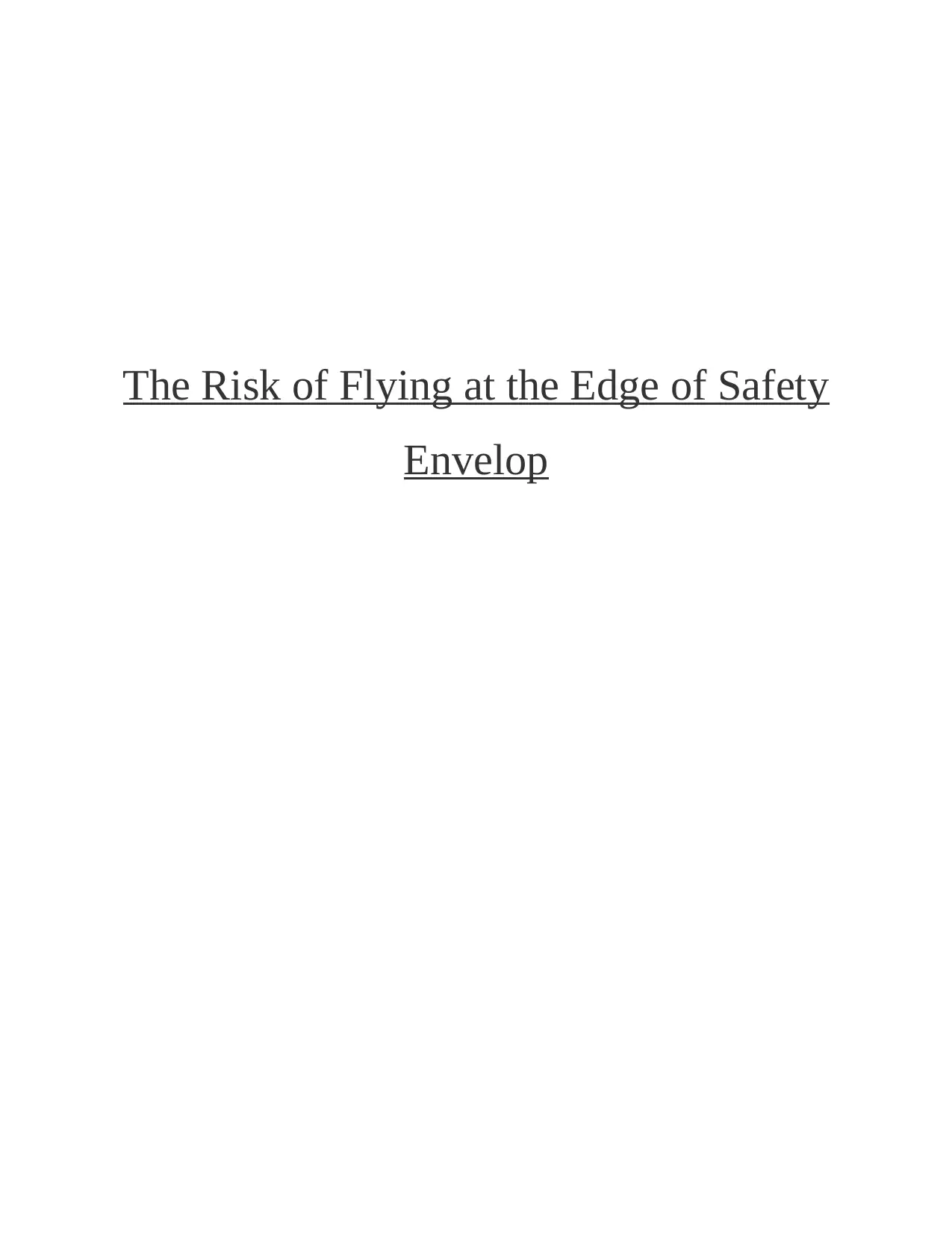
The Risk of Flying at the Edge of Safety
Envelop
Envelop
Secure Best Marks with AI Grader
Need help grading? Try our AI Grader for instant feedback on your assignments.
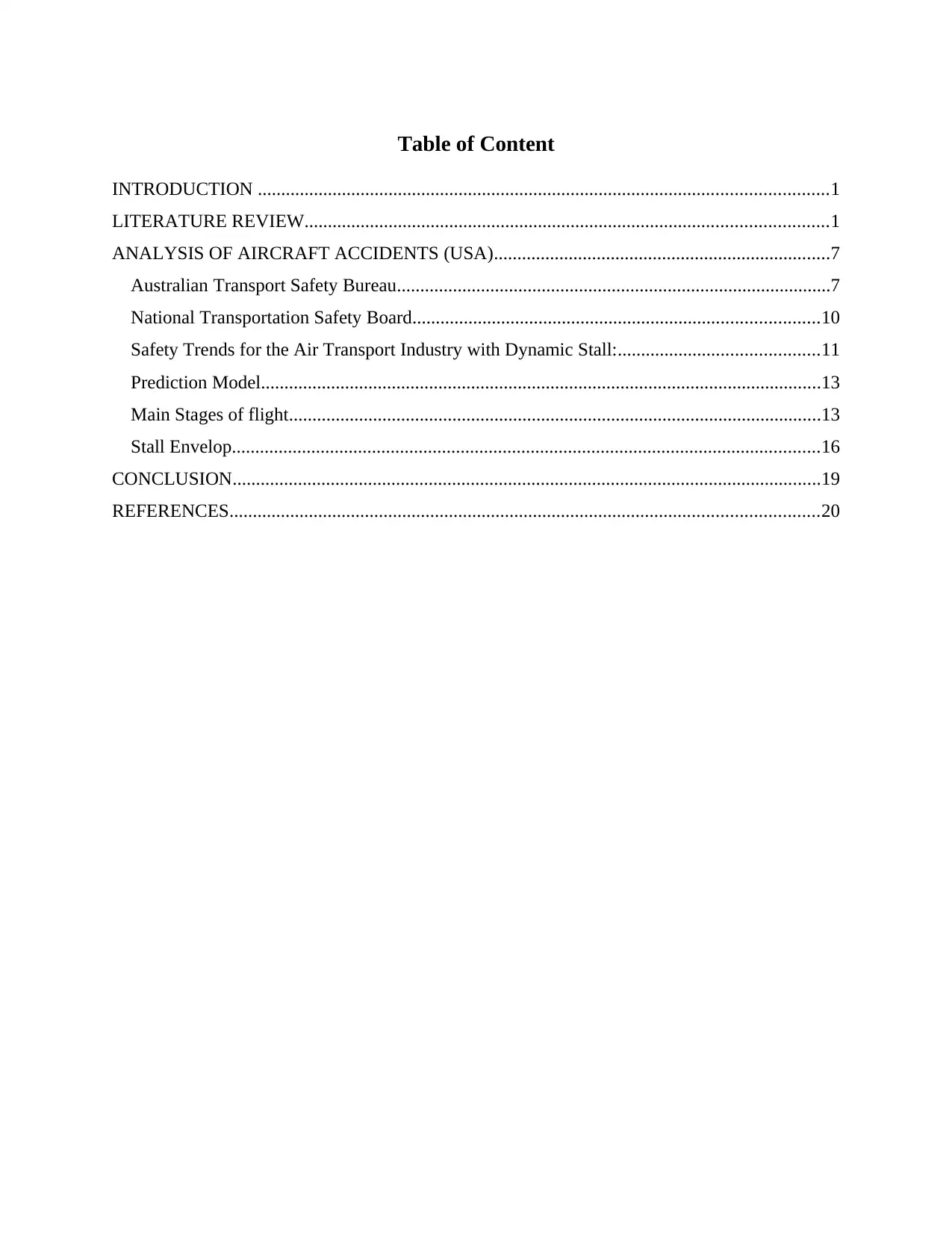
Table of Content
INTRODUCTION ..........................................................................................................................1
LITERATURE REVIEW................................................................................................................1
ANALYSIS OF AIRCRAFT ACCIDENTS (USA)........................................................................7
Australian Transport Safety Bureau.............................................................................................7
National Transportation Safety Board.......................................................................................10
Safety Trends for the Air Transport Industry with Dynamic Stall:...........................................11
Prediction Model........................................................................................................................13
Main Stages of flight..................................................................................................................13
Stall Envelop..............................................................................................................................16
CONCLUSION..............................................................................................................................19
REFERENCES..............................................................................................................................20
INTRODUCTION ..........................................................................................................................1
LITERATURE REVIEW................................................................................................................1
ANALYSIS OF AIRCRAFT ACCIDENTS (USA)........................................................................7
Australian Transport Safety Bureau.............................................................................................7
National Transportation Safety Board.......................................................................................10
Safety Trends for the Air Transport Industry with Dynamic Stall:...........................................11
Prediction Model........................................................................................................................13
Main Stages of flight..................................................................................................................13
Stall Envelop..............................................................................................................................16
CONCLUSION..............................................................................................................................19
REFERENCES..............................................................................................................................20
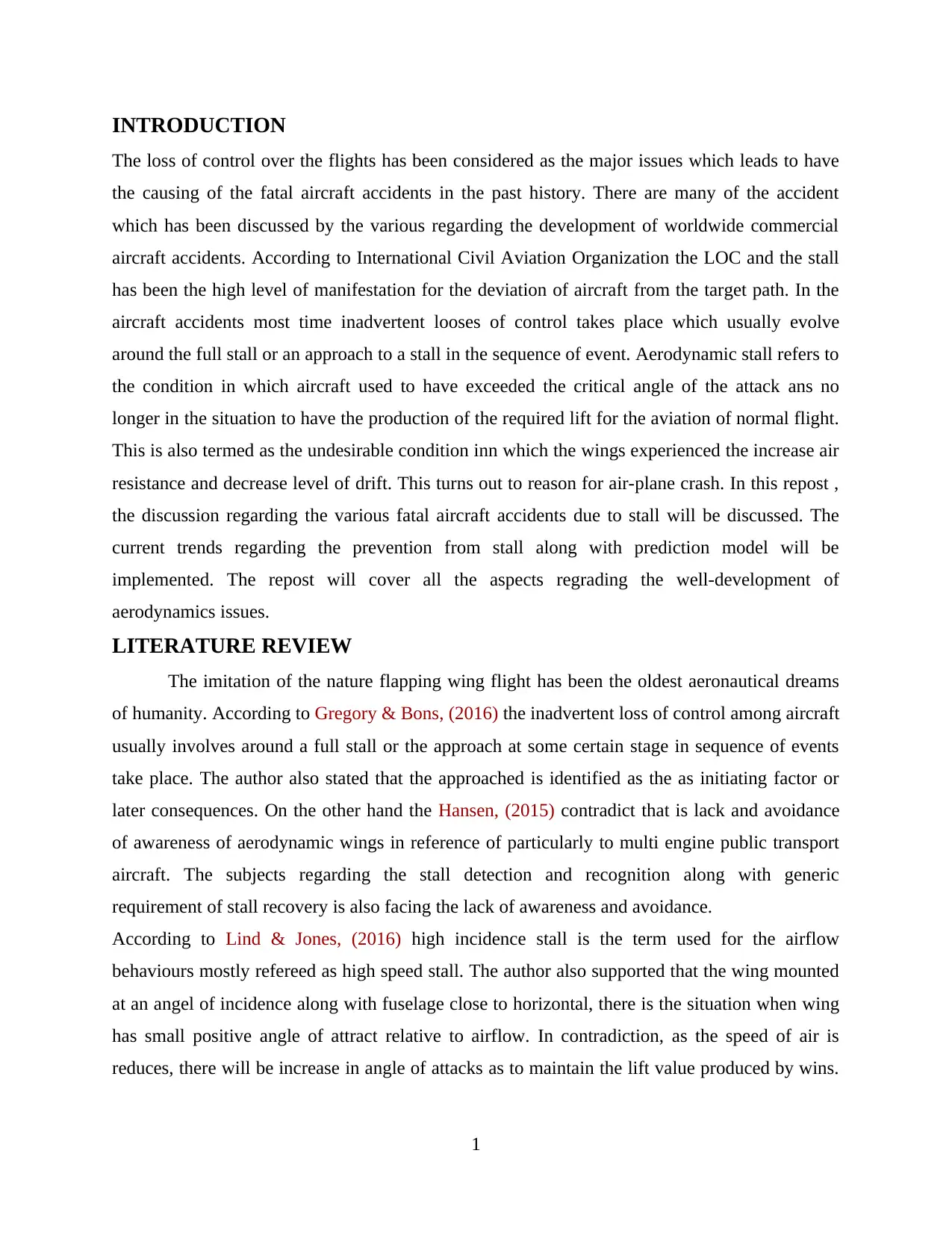
INTRODUCTION
The loss of control over the flights has been considered as the major issues which leads to have
the causing of the fatal aircraft accidents in the past history. There are many of the accident
which has been discussed by the various regarding the development of worldwide commercial
aircraft accidents. According to International Civil Aviation Organization the LOC and the stall
has been the high level of manifestation for the deviation of aircraft from the target path. In the
aircraft accidents most time inadvertent looses of control takes place which usually evolve
around the full stall or an approach to a stall in the sequence of event. Aerodynamic stall refers to
the condition in which aircraft used to have exceeded the critical angle of the attack ans no
longer in the situation to have the production of the required lift for the aviation of normal flight.
This is also termed as the undesirable condition inn which the wings experienced the increase air
resistance and decrease level of drift. This turns out to reason for air-plane crash. In this repost ,
the discussion regarding the various fatal aircraft accidents due to stall will be discussed. The
current trends regarding the prevention from stall along with prediction model will be
implemented. The repost will cover all the aspects regrading the well-development of
aerodynamics issues.
LITERATURE REVIEW
The imitation of the nature flapping wing flight has been the oldest aeronautical dreams
of humanity. According to Gregory & Bons, (2016) the inadvertent loss of control among aircraft
usually involves around a full stall or the approach at some certain stage in sequence of events
take place. The author also stated that the approached is identified as the as initiating factor or
later consequences. On the other hand the Hansen, (2015) contradict that is lack and avoidance
of awareness of aerodynamic wings in reference of particularly to multi engine public transport
aircraft. The subjects regarding the stall detection and recognition along with generic
requirement of stall recovery is also facing the lack of awareness and avoidance.
According to Lind & Jones, (2016) high incidence stall is the term used for the airflow
behaviours mostly refereed as high speed stall. The author also supported that the wing mounted
at an angel of incidence along with fuselage close to horizontal, there is the situation when wing
has small positive angle of attract relative to airflow. In contradiction, as the speed of air is
reduces, there will be increase in angle of attacks as to maintain the lift value produced by wins.
1
The loss of control over the flights has been considered as the major issues which leads to have
the causing of the fatal aircraft accidents in the past history. There are many of the accident
which has been discussed by the various regarding the development of worldwide commercial
aircraft accidents. According to International Civil Aviation Organization the LOC and the stall
has been the high level of manifestation for the deviation of aircraft from the target path. In the
aircraft accidents most time inadvertent looses of control takes place which usually evolve
around the full stall or an approach to a stall in the sequence of event. Aerodynamic stall refers to
the condition in which aircraft used to have exceeded the critical angle of the attack ans no
longer in the situation to have the production of the required lift for the aviation of normal flight.
This is also termed as the undesirable condition inn which the wings experienced the increase air
resistance and decrease level of drift. This turns out to reason for air-plane crash. In this repost ,
the discussion regarding the various fatal aircraft accidents due to stall will be discussed. The
current trends regarding the prevention from stall along with prediction model will be
implemented. The repost will cover all the aspects regrading the well-development of
aerodynamics issues.
LITERATURE REVIEW
The imitation of the nature flapping wing flight has been the oldest aeronautical dreams
of humanity. According to Gregory & Bons, (2016) the inadvertent loss of control among aircraft
usually involves around a full stall or the approach at some certain stage in sequence of events
take place. The author also stated that the approached is identified as the as initiating factor or
later consequences. On the other hand the Hansen, (2015) contradict that is lack and avoidance
of awareness of aerodynamic wings in reference of particularly to multi engine public transport
aircraft. The subjects regarding the stall detection and recognition along with generic
requirement of stall recovery is also facing the lack of awareness and avoidance.
According to Lind & Jones, (2016) high incidence stall is the term used for the airflow
behaviours mostly refereed as high speed stall. The author also supported that the wing mounted
at an angel of incidence along with fuselage close to horizontal, there is the situation when wing
has small positive angle of attract relative to airflow. In contradiction, as the speed of air is
reduces, there will be increase in angle of attacks as to maintain the lift value produced by wins.
1
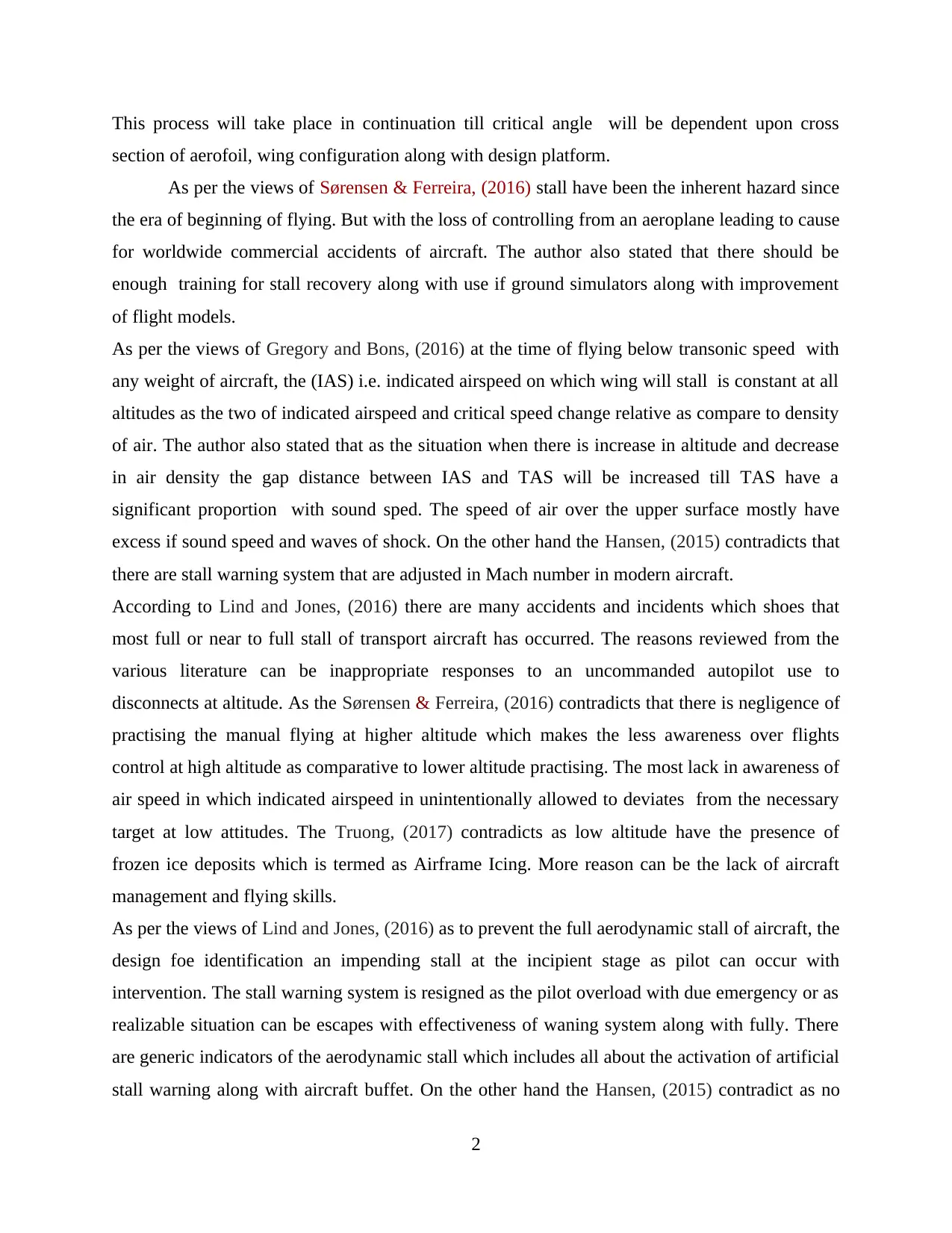
This process will take place in continuation till critical angle will be dependent upon cross
section of aerofoil, wing configuration along with design platform.
As per the views of Sørensen & Ferreira, (2016) stall have been the inherent hazard since
the era of beginning of flying. But with the loss of controlling from an aeroplane leading to cause
for worldwide commercial accidents of aircraft. The author also stated that there should be
enough training for stall recovery along with use if ground simulators along with improvement
of flight models.
As per the views of Gregory and Bons, (2016) at the time of flying below transonic speed with
any weight of aircraft, the (IAS) i.e. indicated airspeed on which wing will stall is constant at all
altitudes as the two of indicated airspeed and critical speed change relative as compare to density
of air. The author also stated that as the situation when there is increase in altitude and decrease
in air density the gap distance between IAS and TAS will be increased till TAS have a
significant proportion with sound sped. The speed of air over the upper surface mostly have
excess if sound speed and waves of shock. On the other hand the Hansen, (2015) contradicts that
there are stall warning system that are adjusted in Mach number in modern aircraft.
According to Lind and Jones, (2016) there are many accidents and incidents which shoes that
most full or near to full stall of transport aircraft has occurred. The reasons reviewed from the
various literature can be inappropriate responses to an uncommanded autopilot use to
disconnects at altitude. As the Sørensen & Ferreira, (2016) contradicts that there is negligence of
practising the manual flying at higher altitude which makes the less awareness over flights
control at high altitude as comparative to lower altitude practising. The most lack in awareness of
air speed in which indicated airspeed in unintentionally allowed to deviates from the necessary
target at low attitudes. The Truong, (2017) contradicts as low altitude have the presence of
frozen ice deposits which is termed as Airframe Icing. More reason can be the lack of aircraft
management and flying skills.
As per the views of Lind and Jones, (2016) as to prevent the full aerodynamic stall of aircraft, the
design foe identification an impending stall at the incipient stage as pilot can occur with
intervention. The stall warning system is resigned as the pilot overload with due emergency or as
realizable situation can be escapes with effectiveness of waning system along with fully. There
are generic indicators of the aerodynamic stall which includes all about the activation of artificial
stall warning along with aircraft buffet. On the other hand the Hansen, (2015) contradict as no
2
section of aerofoil, wing configuration along with design platform.
As per the views of Sørensen & Ferreira, (2016) stall have been the inherent hazard since
the era of beginning of flying. But with the loss of controlling from an aeroplane leading to cause
for worldwide commercial accidents of aircraft. The author also stated that there should be
enough training for stall recovery along with use if ground simulators along with improvement
of flight models.
As per the views of Gregory and Bons, (2016) at the time of flying below transonic speed with
any weight of aircraft, the (IAS) i.e. indicated airspeed on which wing will stall is constant at all
altitudes as the two of indicated airspeed and critical speed change relative as compare to density
of air. The author also stated that as the situation when there is increase in altitude and decrease
in air density the gap distance between IAS and TAS will be increased till TAS have a
significant proportion with sound sped. The speed of air over the upper surface mostly have
excess if sound speed and waves of shock. On the other hand the Hansen, (2015) contradicts that
there are stall warning system that are adjusted in Mach number in modern aircraft.
According to Lind and Jones, (2016) there are many accidents and incidents which shoes that
most full or near to full stall of transport aircraft has occurred. The reasons reviewed from the
various literature can be inappropriate responses to an uncommanded autopilot use to
disconnects at altitude. As the Sørensen & Ferreira, (2016) contradicts that there is negligence of
practising the manual flying at higher altitude which makes the less awareness over flights
control at high altitude as comparative to lower altitude practising. The most lack in awareness of
air speed in which indicated airspeed in unintentionally allowed to deviates from the necessary
target at low attitudes. The Truong, (2017) contradicts as low altitude have the presence of
frozen ice deposits which is termed as Airframe Icing. More reason can be the lack of aircraft
management and flying skills.
As per the views of Lind and Jones, (2016) as to prevent the full aerodynamic stall of aircraft, the
design foe identification an impending stall at the incipient stage as pilot can occur with
intervention. The stall warning system is resigned as the pilot overload with due emergency or as
realizable situation can be escapes with effectiveness of waning system along with fully. There
are generic indicators of the aerodynamic stall which includes all about the activation of artificial
stall warning along with aircraft buffet. On the other hand the Hansen, (2015) contradict as no
2
Secure Best Marks with AI Grader
Need help grading? Try our AI Grader for instant feedback on your assignments.
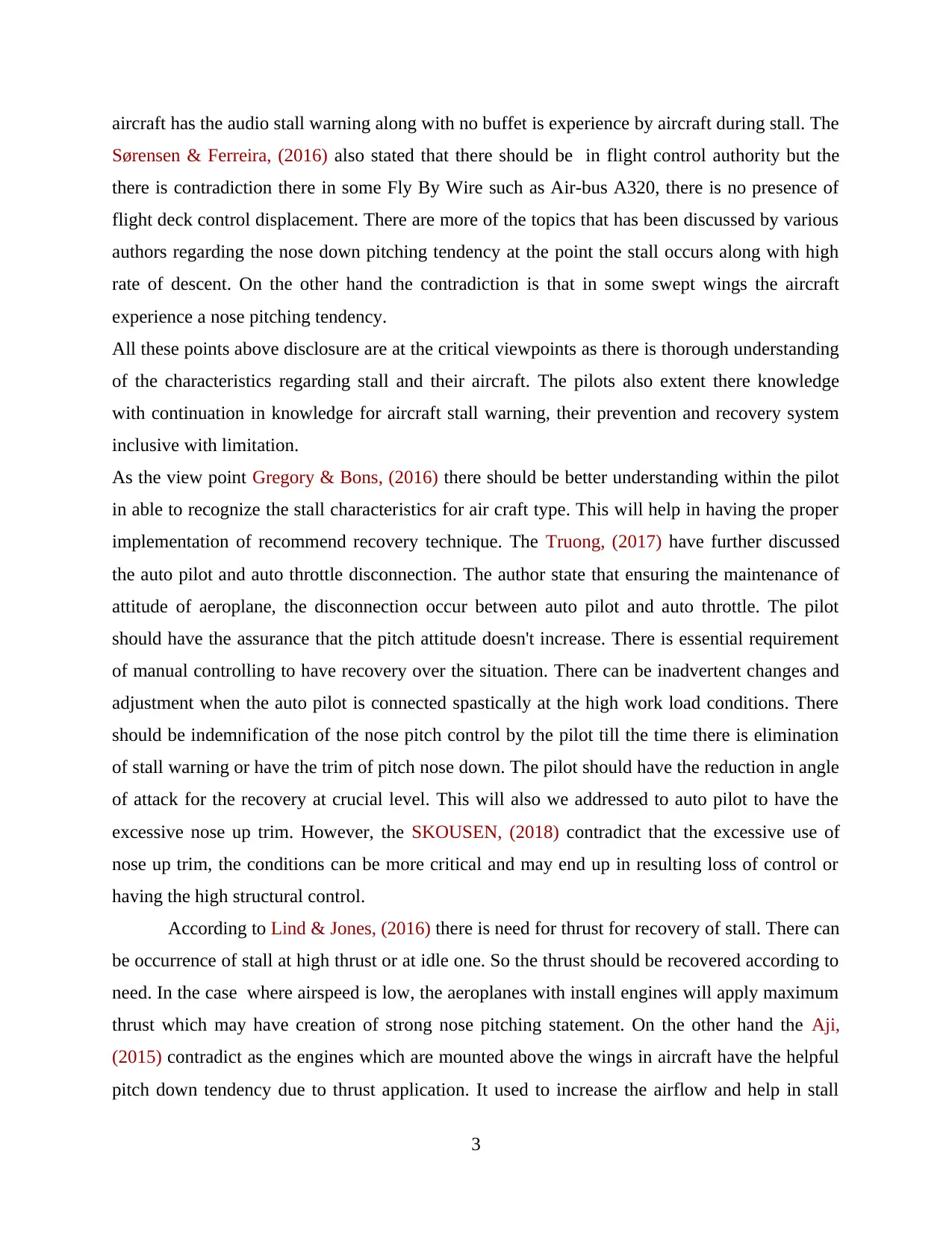
aircraft has the audio stall warning along with no buffet is experience by aircraft during stall. The
Sørensen & Ferreira, (2016) also stated that there should be in flight control authority but the
there is contradiction there in some Fly By Wire such as Air-bus A320, there is no presence of
flight deck control displacement. There are more of the topics that has been discussed by various
authors regarding the nose down pitching tendency at the point the stall occurs along with high
rate of descent. On the other hand the contradiction is that in some swept wings the aircraft
experience a nose pitching tendency.
All these points above disclosure are at the critical viewpoints as there is thorough understanding
of the characteristics regarding stall and their aircraft. The pilots also extent there knowledge
with continuation in knowledge for aircraft stall warning, their prevention and recovery system
inclusive with limitation.
As the view point Gregory & Bons, (2016) there should be better understanding within the pilot
in able to recognize the stall characteristics for air craft type. This will help in having the proper
implementation of recommend recovery technique. The Truong, (2017) have further discussed
the auto pilot and auto throttle disconnection. The author state that ensuring the maintenance of
attitude of aeroplane, the disconnection occur between auto pilot and auto throttle. The pilot
should have the assurance that the pitch attitude doesn't increase. There is essential requirement
of manual controlling to have recovery over the situation. There can be inadvertent changes and
adjustment when the auto pilot is connected spastically at the high work load conditions. There
should be indemnification of the nose pitch control by the pilot till the time there is elimination
of stall warning or have the trim of pitch nose down. The pilot should have the reduction in angle
of attack for the recovery at crucial level. This will also we addressed to auto pilot to have the
excessive nose up trim. However, the SKOUSEN, (2018) contradict that the excessive use of
nose up trim, the conditions can be more critical and may end up in resulting loss of control or
having the high structural control.
According to Lind & Jones, (2016) there is need for thrust for recovery of stall. There can
be occurrence of stall at high thrust or at idle one. So the thrust should be recovered according to
need. In the case where airspeed is low, the aeroplanes with install engines will apply maximum
thrust which may have creation of strong nose pitching statement. On the other hand the Aji,
(2015) contradict as the engines which are mounted above the wings in aircraft have the helpful
pitch down tendency due to thrust application. It used to increase the airflow and help in stall
3
Sørensen & Ferreira, (2016) also stated that there should be in flight control authority but the
there is contradiction there in some Fly By Wire such as Air-bus A320, there is no presence of
flight deck control displacement. There are more of the topics that has been discussed by various
authors regarding the nose down pitching tendency at the point the stall occurs along with high
rate of descent. On the other hand the contradiction is that in some swept wings the aircraft
experience a nose pitching tendency.
All these points above disclosure are at the critical viewpoints as there is thorough understanding
of the characteristics regarding stall and their aircraft. The pilots also extent there knowledge
with continuation in knowledge for aircraft stall warning, their prevention and recovery system
inclusive with limitation.
As the view point Gregory & Bons, (2016) there should be better understanding within the pilot
in able to recognize the stall characteristics for air craft type. This will help in having the proper
implementation of recommend recovery technique. The Truong, (2017) have further discussed
the auto pilot and auto throttle disconnection. The author state that ensuring the maintenance of
attitude of aeroplane, the disconnection occur between auto pilot and auto throttle. The pilot
should have the assurance that the pitch attitude doesn't increase. There is essential requirement
of manual controlling to have recovery over the situation. There can be inadvertent changes and
adjustment when the auto pilot is connected spastically at the high work load conditions. There
should be indemnification of the nose pitch control by the pilot till the time there is elimination
of stall warning or have the trim of pitch nose down. The pilot should have the reduction in angle
of attack for the recovery at crucial level. This will also we addressed to auto pilot to have the
excessive nose up trim. However, the SKOUSEN, (2018) contradict that the excessive use of
nose up trim, the conditions can be more critical and may end up in resulting loss of control or
having the high structural control.
According to Lind & Jones, (2016) there is need for thrust for recovery of stall. There can
be occurrence of stall at high thrust or at idle one. So the thrust should be recovered according to
need. In the case where airspeed is low, the aeroplanes with install engines will apply maximum
thrust which may have creation of strong nose pitching statement. On the other hand the Aji,
(2015) contradict as the engines which are mounted above the wings in aircraft have the helpful
pitch down tendency due to thrust application. It used to increase the airflow and help in stall
3
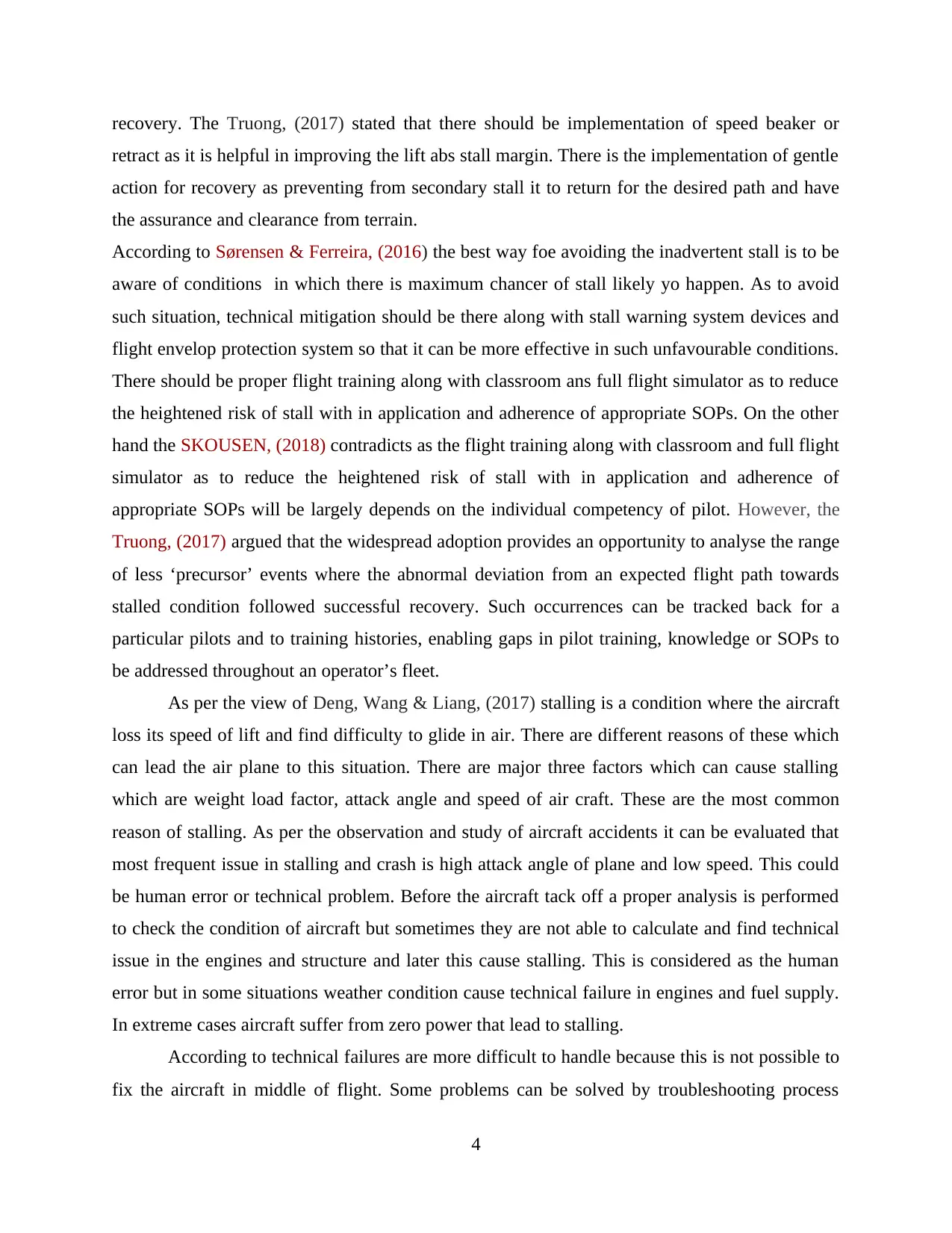
recovery. The Truong, (2017) stated that there should be implementation of speed beaker or
retract as it is helpful in improving the lift abs stall margin. There is the implementation of gentle
action for recovery as preventing from secondary stall it to return for the desired path and have
the assurance and clearance from terrain.
According to Sørensen & Ferreira, (2016) the best way foe avoiding the inadvertent stall is to be
aware of conditions in which there is maximum chancer of stall likely yo happen. As to avoid
such situation, technical mitigation should be there along with stall warning system devices and
flight envelop protection system so that it can be more effective in such unfavourable conditions.
There should be proper flight training along with classroom ans full flight simulator as to reduce
the heightened risk of stall with in application and adherence of appropriate SOPs. On the other
hand the SKOUSEN, (2018) contradicts as the flight training along with classroom and full flight
simulator as to reduce the heightened risk of stall with in application and adherence of
appropriate SOPs will be largely depends on the individual competency of pilot. However, the
Truong, (2017) argued that the widespread adoption provides an opportunity to analyse the range
of less ‘precursor’ events where the abnormal deviation from an expected flight path towards
stalled condition followed successful recovery. Such occurrences can be tracked back for a
particular pilots and to training histories, enabling gaps in pilot training, knowledge or SOPs to
be addressed throughout an operator’s fleet.
As per the view of Deng, Wang & Liang, (2017) stalling is a condition where the aircraft
loss its speed of lift and find difficulty to glide in air. There are different reasons of these which
can lead the air plane to this situation. There are major three factors which can cause stalling
which are weight load factor, attack angle and speed of air craft. These are the most common
reason of stalling. As per the observation and study of aircraft accidents it can be evaluated that
most frequent issue in stalling and crash is high attack angle of plane and low speed. This could
be human error or technical problem. Before the aircraft tack off a proper analysis is performed
to check the condition of aircraft but sometimes they are not able to calculate and find technical
issue in the engines and structure and later this cause stalling. This is considered as the human
error but in some situations weather condition cause technical failure in engines and fuel supply.
In extreme cases aircraft suffer from zero power that lead to stalling.
According to technical failures are more difficult to handle because this is not possible to
fix the aircraft in middle of flight. Some problems can be solved by troubleshooting process
4
retract as it is helpful in improving the lift abs stall margin. There is the implementation of gentle
action for recovery as preventing from secondary stall it to return for the desired path and have
the assurance and clearance from terrain.
According to Sørensen & Ferreira, (2016) the best way foe avoiding the inadvertent stall is to be
aware of conditions in which there is maximum chancer of stall likely yo happen. As to avoid
such situation, technical mitigation should be there along with stall warning system devices and
flight envelop protection system so that it can be more effective in such unfavourable conditions.
There should be proper flight training along with classroom ans full flight simulator as to reduce
the heightened risk of stall with in application and adherence of appropriate SOPs. On the other
hand the SKOUSEN, (2018) contradicts as the flight training along with classroom and full flight
simulator as to reduce the heightened risk of stall with in application and adherence of
appropriate SOPs will be largely depends on the individual competency of pilot. However, the
Truong, (2017) argued that the widespread adoption provides an opportunity to analyse the range
of less ‘precursor’ events where the abnormal deviation from an expected flight path towards
stalled condition followed successful recovery. Such occurrences can be tracked back for a
particular pilots and to training histories, enabling gaps in pilot training, knowledge or SOPs to
be addressed throughout an operator’s fleet.
As per the view of Deng, Wang & Liang, (2017) stalling is a condition where the aircraft
loss its speed of lift and find difficulty to glide in air. There are different reasons of these which
can lead the air plane to this situation. There are major three factors which can cause stalling
which are weight load factor, attack angle and speed of air craft. These are the most common
reason of stalling. As per the observation and study of aircraft accidents it can be evaluated that
most frequent issue in stalling and crash is high attack angle of plane and low speed. This could
be human error or technical problem. Before the aircraft tack off a proper analysis is performed
to check the condition of aircraft but sometimes they are not able to calculate and find technical
issue in the engines and structure and later this cause stalling. This is considered as the human
error but in some situations weather condition cause technical failure in engines and fuel supply.
In extreme cases aircraft suffer from zero power that lead to stalling.
According to technical failures are more difficult to handle because this is not possible to
fix the aircraft in middle of flight. Some problems can be solved by troubleshooting process
4
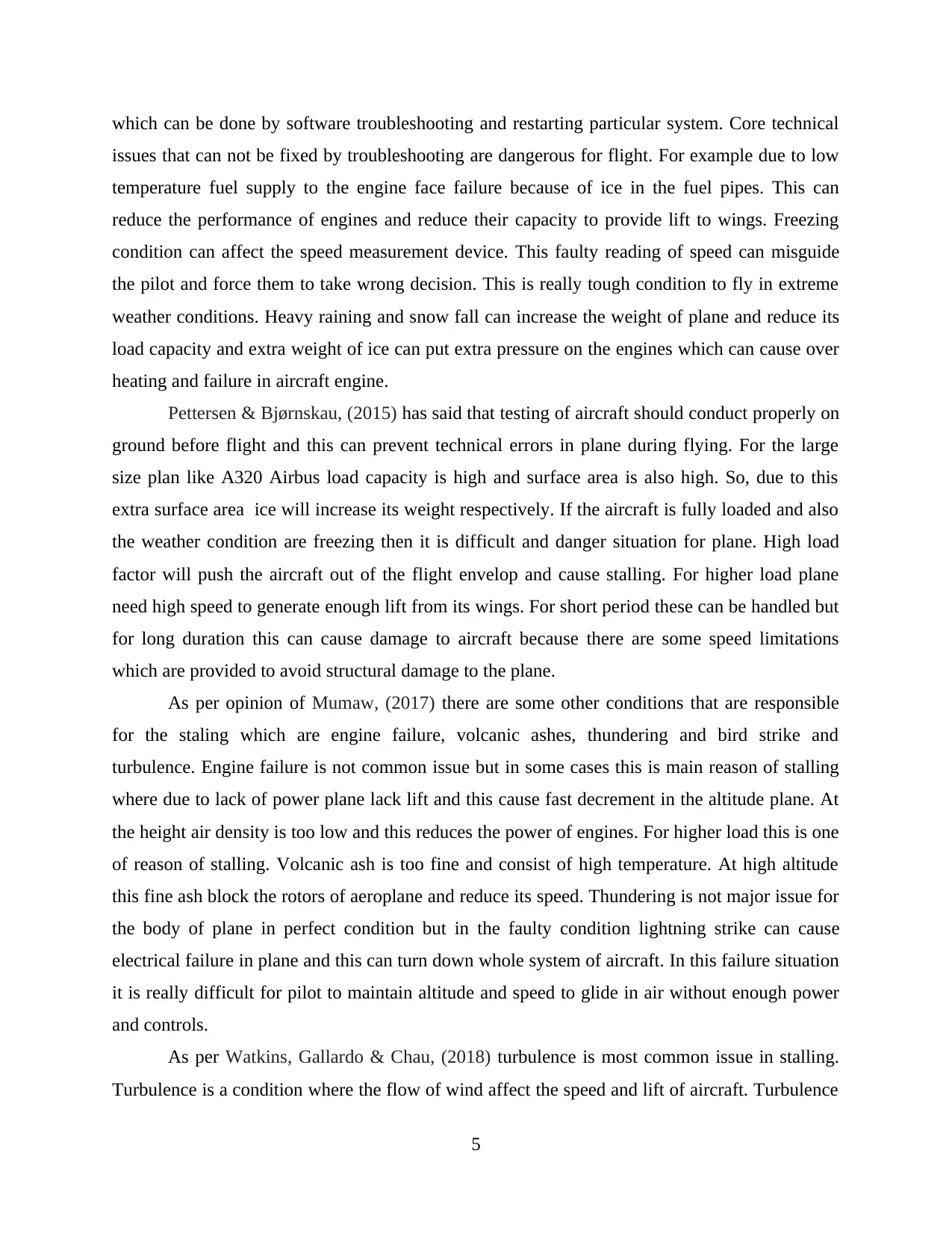
which can be done by software troubleshooting and restarting particular system. Core technical
issues that can not be fixed by troubleshooting are dangerous for flight. For example due to low
temperature fuel supply to the engine face failure because of ice in the fuel pipes. This can
reduce the performance of engines and reduce their capacity to provide lift to wings. Freezing
condition can affect the speed measurement device. This faulty reading of speed can misguide
the pilot and force them to take wrong decision. This is really tough condition to fly in extreme
weather conditions. Heavy raining and snow fall can increase the weight of plane and reduce its
load capacity and extra weight of ice can put extra pressure on the engines which can cause over
heating and failure in aircraft engine.
Pettersen & Bjørnskau, (2015) has said that testing of aircraft should conduct properly on
ground before flight and this can prevent technical errors in plane during flying. For the large
size plan like A320 Airbus load capacity is high and surface area is also high. So, due to this
extra surface area ice will increase its weight respectively. If the aircraft is fully loaded and also
the weather condition are freezing then it is difficult and danger situation for plane. High load
factor will push the aircraft out of the flight envelop and cause stalling. For higher load plane
need high speed to generate enough lift from its wings. For short period these can be handled but
for long duration this can cause damage to aircraft because there are some speed limitations
which are provided to avoid structural damage to the plane.
As per opinion of Mumaw, (2017) there are some other conditions that are responsible
for the staling which are engine failure, volcanic ashes, thundering and bird strike and
turbulence. Engine failure is not common issue but in some cases this is main reason of stalling
where due to lack of power plane lack lift and this cause fast decrement in the altitude plane. At
the height air density is too low and this reduces the power of engines. For higher load this is one
of reason of stalling. Volcanic ash is too fine and consist of high temperature. At high altitude
this fine ash block the rotors of aeroplane and reduce its speed. Thundering is not major issue for
the body of plane in perfect condition but in the faulty condition lightning strike can cause
electrical failure in plane and this can turn down whole system of aircraft. In this failure situation
it is really difficult for pilot to maintain altitude and speed to glide in air without enough power
and controls.
As per Watkins, Gallardo & Chau, (2018) turbulence is most common issue in stalling.
Turbulence is a condition where the flow of wind affect the speed and lift of aircraft. Turbulence
5
issues that can not be fixed by troubleshooting are dangerous for flight. For example due to low
temperature fuel supply to the engine face failure because of ice in the fuel pipes. This can
reduce the performance of engines and reduce their capacity to provide lift to wings. Freezing
condition can affect the speed measurement device. This faulty reading of speed can misguide
the pilot and force them to take wrong decision. This is really tough condition to fly in extreme
weather conditions. Heavy raining and snow fall can increase the weight of plane and reduce its
load capacity and extra weight of ice can put extra pressure on the engines which can cause over
heating and failure in aircraft engine.
Pettersen & Bjørnskau, (2015) has said that testing of aircraft should conduct properly on
ground before flight and this can prevent technical errors in plane during flying. For the large
size plan like A320 Airbus load capacity is high and surface area is also high. So, due to this
extra surface area ice will increase its weight respectively. If the aircraft is fully loaded and also
the weather condition are freezing then it is difficult and danger situation for plane. High load
factor will push the aircraft out of the flight envelop and cause stalling. For higher load plane
need high speed to generate enough lift from its wings. For short period these can be handled but
for long duration this can cause damage to aircraft because there are some speed limitations
which are provided to avoid structural damage to the plane.
As per opinion of Mumaw, (2017) there are some other conditions that are responsible
for the staling which are engine failure, volcanic ashes, thundering and bird strike and
turbulence. Engine failure is not common issue but in some cases this is main reason of stalling
where due to lack of power plane lack lift and this cause fast decrement in the altitude plane. At
the height air density is too low and this reduces the power of engines. For higher load this is one
of reason of stalling. Volcanic ash is too fine and consist of high temperature. At high altitude
this fine ash block the rotors of aeroplane and reduce its speed. Thundering is not major issue for
the body of plane in perfect condition but in the faulty condition lightning strike can cause
electrical failure in plane and this can turn down whole system of aircraft. In this failure situation
it is really difficult for pilot to maintain altitude and speed to glide in air without enough power
and controls.
As per Watkins, Gallardo & Chau, (2018) turbulence is most common issue in stalling.
Turbulence is a condition where the flow of wind affect the speed and lift of aircraft. Turbulence
5
Paraphrase This Document
Need a fresh take? Get an instant paraphrase of this document with our AI Paraphraser
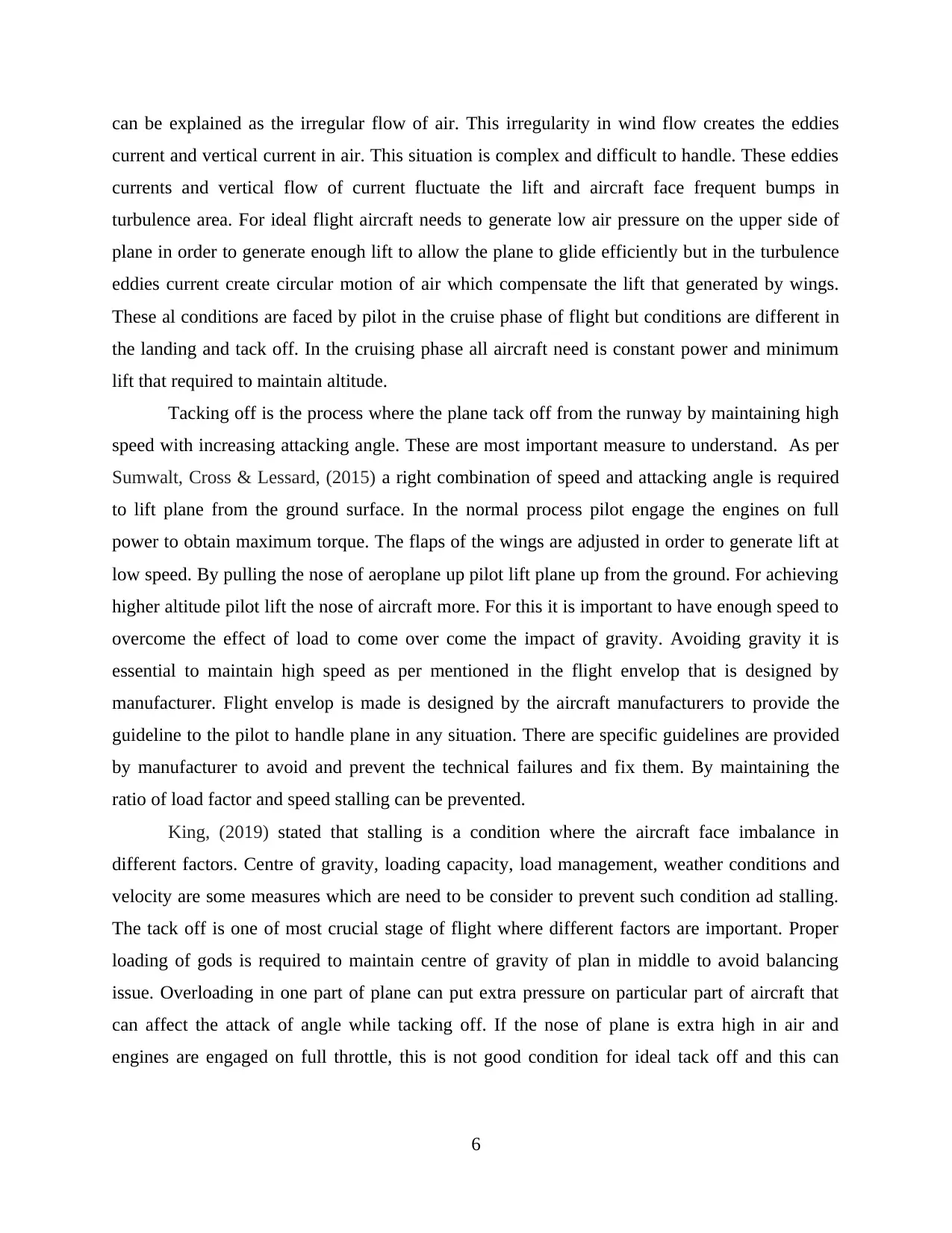
can be explained as the irregular flow of air. This irregularity in wind flow creates the eddies
current and vertical current in air. This situation is complex and difficult to handle. These eddies
currents and vertical flow of current fluctuate the lift and aircraft face frequent bumps in
turbulence area. For ideal flight aircraft needs to generate low air pressure on the upper side of
plane in order to generate enough lift to allow the plane to glide efficiently but in the turbulence
eddies current create circular motion of air which compensate the lift that generated by wings.
These al conditions are faced by pilot in the cruise phase of flight but conditions are different in
the landing and tack off. In the cruising phase all aircraft need is constant power and minimum
lift that required to maintain altitude.
Tacking off is the process where the plane tack off from the runway by maintaining high
speed with increasing attacking angle. These are most important measure to understand. As per
Sumwalt, Cross & Lessard, (2015) a right combination of speed and attacking angle is required
to lift plane from the ground surface. In the normal process pilot engage the engines on full
power to obtain maximum torque. The flaps of the wings are adjusted in order to generate lift at
low speed. By pulling the nose of aeroplane up pilot lift plane up from the ground. For achieving
higher altitude pilot lift the nose of aircraft more. For this it is important to have enough speed to
overcome the effect of load to come over come the impact of gravity. Avoiding gravity it is
essential to maintain high speed as per mentioned in the flight envelop that is designed by
manufacturer. Flight envelop is made is designed by the aircraft manufacturers to provide the
guideline to the pilot to handle plane in any situation. There are specific guidelines are provided
by manufacturer to avoid and prevent the technical failures and fix them. By maintaining the
ratio of load factor and speed stalling can be prevented.
King, (2019) stated that stalling is a condition where the aircraft face imbalance in
different factors. Centre of gravity, loading capacity, load management, weather conditions and
velocity are some measures which are need to be consider to prevent such condition ad stalling.
The tack off is one of most crucial stage of flight where different factors are important. Proper
loading of gods is required to maintain centre of gravity of plan in middle to avoid balancing
issue. Overloading in one part of plane can put extra pressure on particular part of aircraft that
can affect the attack of angle while tacking off. If the nose of plane is extra high in air and
engines are engaged on full throttle, this is not good condition for ideal tack off and this can
6
current and vertical current in air. This situation is complex and difficult to handle. These eddies
currents and vertical flow of current fluctuate the lift and aircraft face frequent bumps in
turbulence area. For ideal flight aircraft needs to generate low air pressure on the upper side of
plane in order to generate enough lift to allow the plane to glide efficiently but in the turbulence
eddies current create circular motion of air which compensate the lift that generated by wings.
These al conditions are faced by pilot in the cruise phase of flight but conditions are different in
the landing and tack off. In the cruising phase all aircraft need is constant power and minimum
lift that required to maintain altitude.
Tacking off is the process where the plane tack off from the runway by maintaining high
speed with increasing attacking angle. These are most important measure to understand. As per
Sumwalt, Cross & Lessard, (2015) a right combination of speed and attacking angle is required
to lift plane from the ground surface. In the normal process pilot engage the engines on full
power to obtain maximum torque. The flaps of the wings are adjusted in order to generate lift at
low speed. By pulling the nose of aeroplane up pilot lift plane up from the ground. For achieving
higher altitude pilot lift the nose of aircraft more. For this it is important to have enough speed to
overcome the effect of load to come over come the impact of gravity. Avoiding gravity it is
essential to maintain high speed as per mentioned in the flight envelop that is designed by
manufacturer. Flight envelop is made is designed by the aircraft manufacturers to provide the
guideline to the pilot to handle plane in any situation. There are specific guidelines are provided
by manufacturer to avoid and prevent the technical failures and fix them. By maintaining the
ratio of load factor and speed stalling can be prevented.
King, (2019) stated that stalling is a condition where the aircraft face imbalance in
different factors. Centre of gravity, loading capacity, load management, weather conditions and
velocity are some measures which are need to be consider to prevent such condition ad stalling.
The tack off is one of most crucial stage of flight where different factors are important. Proper
loading of gods is required to maintain centre of gravity of plan in middle to avoid balancing
issue. Overloading in one part of plane can put extra pressure on particular part of aircraft that
can affect the attack of angle while tacking off. If the nose of plane is extra high in air and
engines are engaged on full throttle, this is not good condition for ideal tack off and this can
6
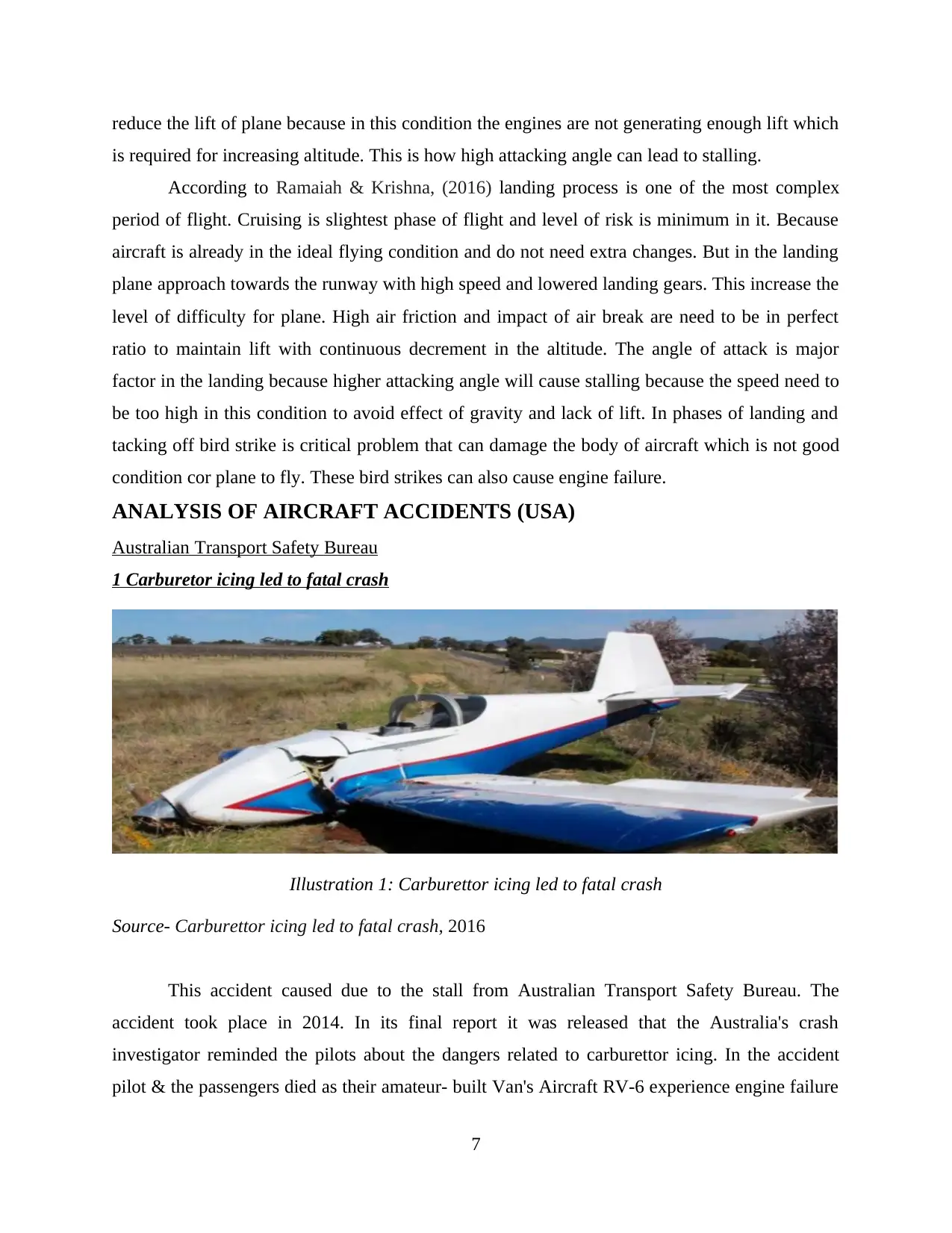
reduce the lift of plane because in this condition the engines are not generating enough lift which
is required for increasing altitude. This is how high attacking angle can lead to stalling.
According to Ramaiah & Krishna, (2016) landing process is one of the most complex
period of flight. Cruising is slightest phase of flight and level of risk is minimum in it. Because
aircraft is already in the ideal flying condition and do not need extra changes. But in the landing
plane approach towards the runway with high speed and lowered landing gears. This increase the
level of difficulty for plane. High air friction and impact of air break are need to be in perfect
ratio to maintain lift with continuous decrement in the altitude. The angle of attack is major
factor in the landing because higher attacking angle will cause stalling because the speed need to
be too high in this condition to avoid effect of gravity and lack of lift. In phases of landing and
tacking off bird strike is critical problem that can damage the body of aircraft which is not good
condition cor plane to fly. These bird strikes can also cause engine failure.
ANALYSIS OF AIRCRAFT ACCIDENTS (USA)
Australian Transport Safety Bureau
1 Carburetor icing led to fatal crash
Illustration 1: Carburettor icing led to fatal crash
Source- Carburettor icing led to fatal crash, 2016
This accident caused due to the stall from Australian Transport Safety Bureau. The
accident took place in 2014. In its final report it was released that the Australia's crash
investigator reminded the pilots about the dangers related to carburettor icing. In the accident
pilot & the passengers died as their amateur- built Van's Aircraft RV-6 experience engine failure
7
is required for increasing altitude. This is how high attacking angle can lead to stalling.
According to Ramaiah & Krishna, (2016) landing process is one of the most complex
period of flight. Cruising is slightest phase of flight and level of risk is minimum in it. Because
aircraft is already in the ideal flying condition and do not need extra changes. But in the landing
plane approach towards the runway with high speed and lowered landing gears. This increase the
level of difficulty for plane. High air friction and impact of air break are need to be in perfect
ratio to maintain lift with continuous decrement in the altitude. The angle of attack is major
factor in the landing because higher attacking angle will cause stalling because the speed need to
be too high in this condition to avoid effect of gravity and lack of lift. In phases of landing and
tacking off bird strike is critical problem that can damage the body of aircraft which is not good
condition cor plane to fly. These bird strikes can also cause engine failure.
ANALYSIS OF AIRCRAFT ACCIDENTS (USA)
Australian Transport Safety Bureau
1 Carburetor icing led to fatal crash
Illustration 1: Carburettor icing led to fatal crash
Source- Carburettor icing led to fatal crash, 2016
This accident caused due to the stall from Australian Transport Safety Bureau. The
accident took place in 2014. In its final report it was released that the Australia's crash
investigator reminded the pilots about the dangers related to carburettor icing. In the accident
pilot & the passengers died as their amateur- built Van's Aircraft RV-6 experience engine failure
7
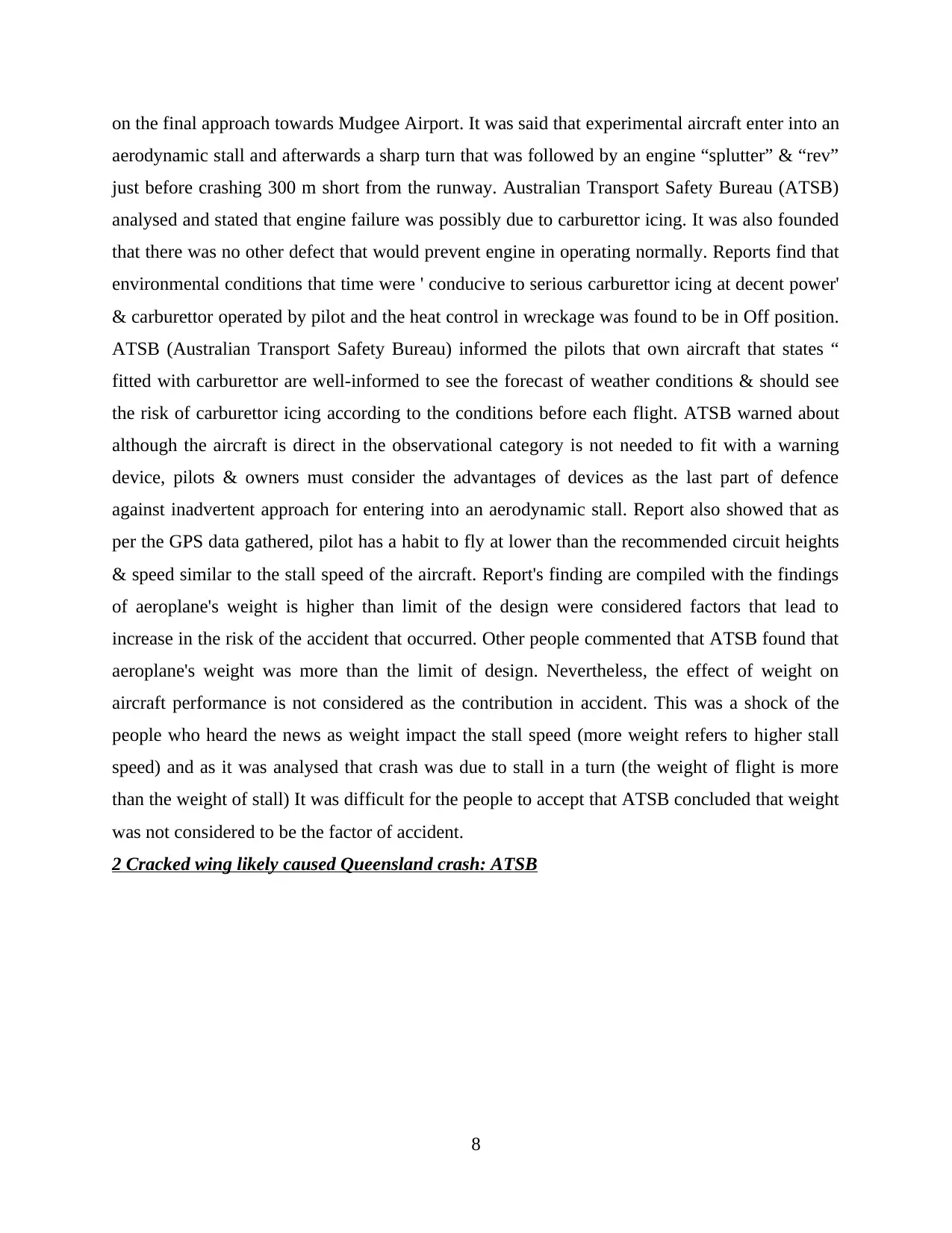
on the final approach towards Mudgee Airport. It was said that experimental aircraft enter into an
aerodynamic stall and afterwards a sharp turn that was followed by an engine “splutter” & “rev”
just before crashing 300 m short from the runway. Australian Transport Safety Bureau (ATSB)
analysed and stated that engine failure was possibly due to carburettor icing. It was also founded
that there was no other defect that would prevent engine in operating normally. Reports find that
environmental conditions that time were ' conducive to serious carburettor icing at decent power'
& carburettor operated by pilot and the heat control in wreckage was found to be in Off position.
ATSB (Australian Transport Safety Bureau) informed the pilots that own aircraft that states “
fitted with carburettor are well-informed to see the forecast of weather conditions & should see
the risk of carburettor icing according to the conditions before each flight. ATSB warned about
although the aircraft is direct in the observational category is not needed to fit with a warning
device, pilots & owners must consider the advantages of devices as the last part of defence
against inadvertent approach for entering into an aerodynamic stall. Report also showed that as
per the GPS data gathered, pilot has a habit to fly at lower than the recommended circuit heights
& speed similar to the stall speed of the aircraft. Report's finding are compiled with the findings
of aeroplane's weight is higher than limit of the design were considered factors that lead to
increase in the risk of the accident that occurred. Other people commented that ATSB found that
aeroplane's weight was more than the limit of design. Nevertheless, the effect of weight on
aircraft performance is not considered as the contribution in accident. This was a shock of the
people who heard the news as weight impact the stall speed (more weight refers to higher stall
speed) and as it was analysed that crash was due to stall in a turn (the weight of flight is more
than the weight of stall) It was difficult for the people to accept that ATSB concluded that weight
was not considered to be the factor of accident.
2 Cracked wing likely caused Queensland crash: ATSB
8
aerodynamic stall and afterwards a sharp turn that was followed by an engine “splutter” & “rev”
just before crashing 300 m short from the runway. Australian Transport Safety Bureau (ATSB)
analysed and stated that engine failure was possibly due to carburettor icing. It was also founded
that there was no other defect that would prevent engine in operating normally. Reports find that
environmental conditions that time were ' conducive to serious carburettor icing at decent power'
& carburettor operated by pilot and the heat control in wreckage was found to be in Off position.
ATSB (Australian Transport Safety Bureau) informed the pilots that own aircraft that states “
fitted with carburettor are well-informed to see the forecast of weather conditions & should see
the risk of carburettor icing according to the conditions before each flight. ATSB warned about
although the aircraft is direct in the observational category is not needed to fit with a warning
device, pilots & owners must consider the advantages of devices as the last part of defence
against inadvertent approach for entering into an aerodynamic stall. Report also showed that as
per the GPS data gathered, pilot has a habit to fly at lower than the recommended circuit heights
& speed similar to the stall speed of the aircraft. Report's finding are compiled with the findings
of aeroplane's weight is higher than limit of the design were considered factors that lead to
increase in the risk of the accident that occurred. Other people commented that ATSB found that
aeroplane's weight was more than the limit of design. Nevertheless, the effect of weight on
aircraft performance is not considered as the contribution in accident. This was a shock of the
people who heard the news as weight impact the stall speed (more weight refers to higher stall
speed) and as it was analysed that crash was due to stall in a turn (the weight of flight is more
than the weight of stall) It was difficult for the people to accept that ATSB concluded that weight
was not considered to be the factor of accident.
2 Cracked wing likely caused Queensland crash: ATSB
8
Secure Best Marks with AI Grader
Need help grading? Try our AI Grader for instant feedback on your assignments.
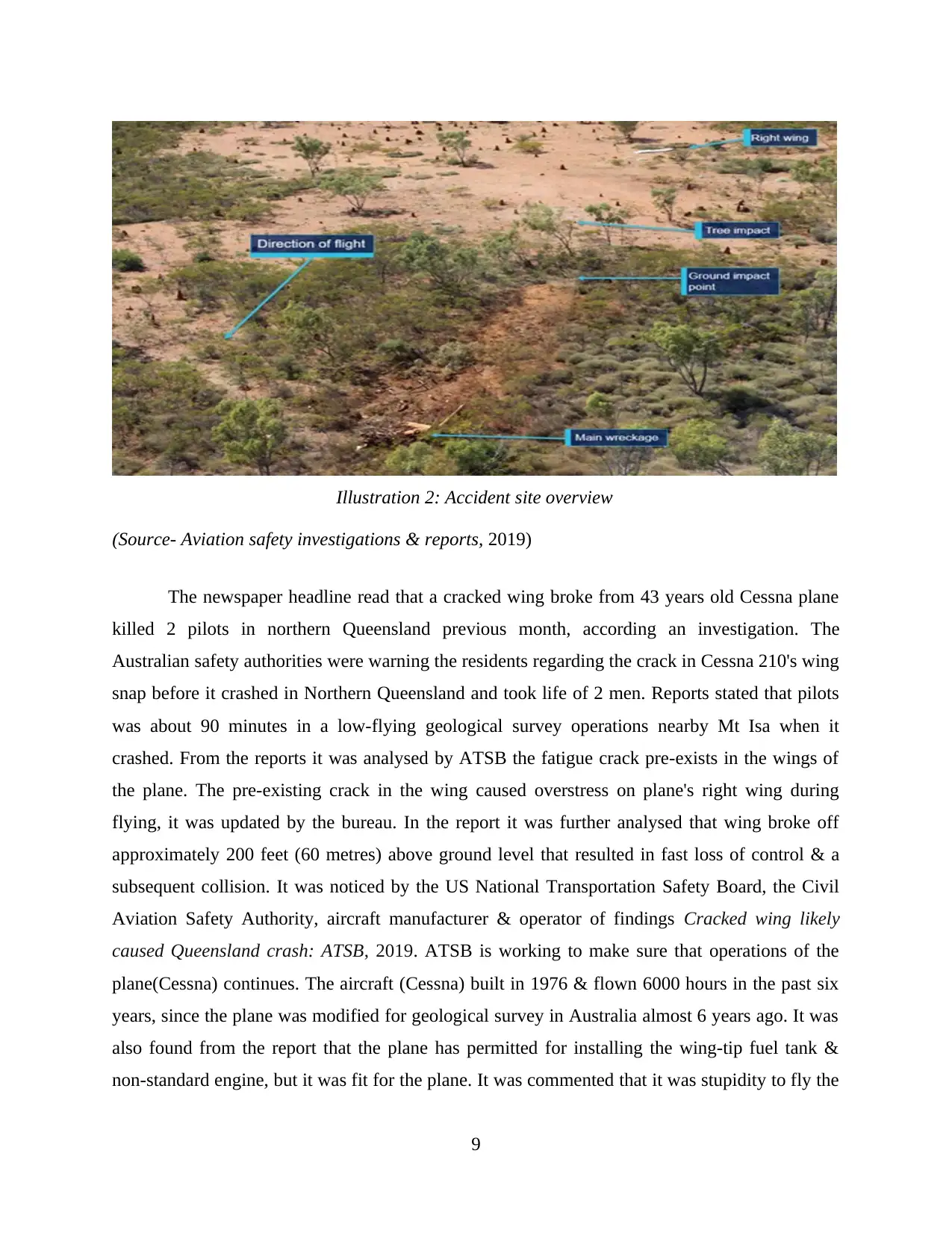
Illustration 2: Accident site overview
(Source- Aviation safety investigations & reports, 2019)
The newspaper headline read that a cracked wing broke from 43 years old Cessna plane
killed 2 pilots in northern Queensland previous month, according an investigation. The
Australian safety authorities were warning the residents regarding the crack in Cessna 210's wing
snap before it crashed in Northern Queensland and took life of 2 men. Reports stated that pilots
was about 90 minutes in a low-flying geological survey operations nearby Mt Isa when it
crashed. From the reports it was analysed by ATSB the fatigue crack pre-exists in the wings of
the plane. The pre-existing crack in the wing caused overstress on plane's right wing during
flying, it was updated by the bureau. In the report it was further analysed that wing broke off
approximately 200 feet (60 metres) above ground level that resulted in fast loss of control & a
subsequent collision. It was noticed by the US National Transportation Safety Board, the Civil
Aviation Safety Authority, aircraft manufacturer & operator of findings Cracked wing likely
caused Queensland crash: ATSB, 2019. ATSB is working to make sure that operations of the
plane(Cessna) continues. The aircraft (Cessna) built in 1976 & flown 6000 hours in the past six
years, since the plane was modified for geological survey in Australia almost 6 years ago. It was
also found from the report that the plane has permitted for installing the wing-tip fuel tank &
non-standard engine, but it was fit for the plane. It was commented that it was stupidity to fly the
9
(Source- Aviation safety investigations & reports, 2019)
The newspaper headline read that a cracked wing broke from 43 years old Cessna plane
killed 2 pilots in northern Queensland previous month, according an investigation. The
Australian safety authorities were warning the residents regarding the crack in Cessna 210's wing
snap before it crashed in Northern Queensland and took life of 2 men. Reports stated that pilots
was about 90 minutes in a low-flying geological survey operations nearby Mt Isa when it
crashed. From the reports it was analysed by ATSB the fatigue crack pre-exists in the wings of
the plane. The pre-existing crack in the wing caused overstress on plane's right wing during
flying, it was updated by the bureau. In the report it was further analysed that wing broke off
approximately 200 feet (60 metres) above ground level that resulted in fast loss of control & a
subsequent collision. It was noticed by the US National Transportation Safety Board, the Civil
Aviation Safety Authority, aircraft manufacturer & operator of findings Cracked wing likely
caused Queensland crash: ATSB, 2019. ATSB is working to make sure that operations of the
plane(Cessna) continues. The aircraft (Cessna) built in 1976 & flown 6000 hours in the past six
years, since the plane was modified for geological survey in Australia almost 6 years ago. It was
also found from the report that the plane has permitted for installing the wing-tip fuel tank &
non-standard engine, but it was fit for the plane. It was commented that it was stupidity to fly the
9
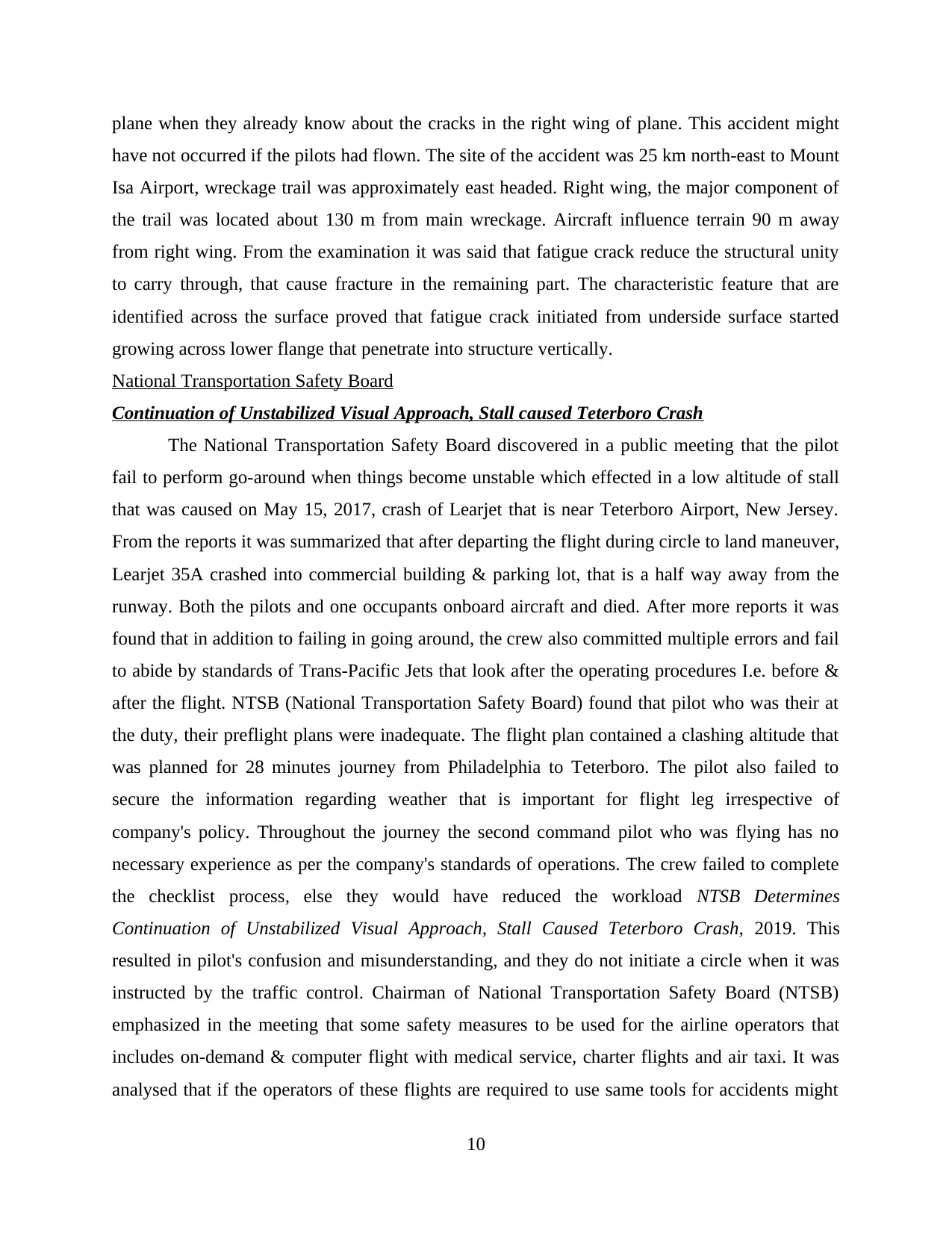
plane when they already know about the cracks in the right wing of plane. This accident might
have not occurred if the pilots had flown. The site of the accident was 25 km north-east to Mount
Isa Airport, wreckage trail was approximately east headed. Right wing, the major component of
the trail was located about 130 m from main wreckage. Aircraft influence terrain 90 m away
from right wing. From the examination it was said that fatigue crack reduce the structural unity
to carry through, that cause fracture in the remaining part. The characteristic feature that are
identified across the surface proved that fatigue crack initiated from underside surface started
growing across lower flange that penetrate into structure vertically.
National Transportation Safety Board
Continuation of Unstabilized Visual Approach, Stall caused Teterboro Crash
The National Transportation Safety Board discovered in a public meeting that the pilot
fail to perform go-around when things become unstable which effected in a low altitude of stall
that was caused on May 15, 2017, crash of Learjet that is near Teterboro Airport, New Jersey.
From the reports it was summarized that after departing the flight during circle to land maneuver,
Learjet 35A crashed into commercial building & parking lot, that is a half way away from the
runway. Both the pilots and one occupants onboard aircraft and died. After more reports it was
found that in addition to failing in going around, the crew also committed multiple errors and fail
to abide by standards of Trans-Pacific Jets that look after the operating procedures I.e. before &
after the flight. NTSB (National Transportation Safety Board) found that pilot who was their at
the duty, their preflight plans were inadequate. The flight plan contained a clashing altitude that
was planned for 28 minutes journey from Philadelphia to Teterboro. The pilot also failed to
secure the information regarding weather that is important for flight leg irrespective of
company's policy. Throughout the journey the second command pilot who was flying has no
necessary experience as per the company's standards of operations. The crew failed to complete
the checklist process, else they would have reduced the workload NTSB Determines
Continuation of Unstabilized Visual Approach, Stall Caused Teterboro Crash, 2019. This
resulted in pilot's confusion and misunderstanding, and they do not initiate a circle when it was
instructed by the traffic control. Chairman of National Transportation Safety Board (NTSB)
emphasized in the meeting that some safety measures to be used for the airline operators that
includes on-demand & computer flight with medical service, charter flights and air taxi. It was
analysed that if the operators of these flights are required to use same tools for accidents might
10
have not occurred if the pilots had flown. The site of the accident was 25 km north-east to Mount
Isa Airport, wreckage trail was approximately east headed. Right wing, the major component of
the trail was located about 130 m from main wreckage. Aircraft influence terrain 90 m away
from right wing. From the examination it was said that fatigue crack reduce the structural unity
to carry through, that cause fracture in the remaining part. The characteristic feature that are
identified across the surface proved that fatigue crack initiated from underside surface started
growing across lower flange that penetrate into structure vertically.
National Transportation Safety Board
Continuation of Unstabilized Visual Approach, Stall caused Teterboro Crash
The National Transportation Safety Board discovered in a public meeting that the pilot
fail to perform go-around when things become unstable which effected in a low altitude of stall
that was caused on May 15, 2017, crash of Learjet that is near Teterboro Airport, New Jersey.
From the reports it was summarized that after departing the flight during circle to land maneuver,
Learjet 35A crashed into commercial building & parking lot, that is a half way away from the
runway. Both the pilots and one occupants onboard aircraft and died. After more reports it was
found that in addition to failing in going around, the crew also committed multiple errors and fail
to abide by standards of Trans-Pacific Jets that look after the operating procedures I.e. before &
after the flight. NTSB (National Transportation Safety Board) found that pilot who was their at
the duty, their preflight plans were inadequate. The flight plan contained a clashing altitude that
was planned for 28 minutes journey from Philadelphia to Teterboro. The pilot also failed to
secure the information regarding weather that is important for flight leg irrespective of
company's policy. Throughout the journey the second command pilot who was flying has no
necessary experience as per the company's standards of operations. The crew failed to complete
the checklist process, else they would have reduced the workload NTSB Determines
Continuation of Unstabilized Visual Approach, Stall Caused Teterboro Crash, 2019. This
resulted in pilot's confusion and misunderstanding, and they do not initiate a circle when it was
instructed by the traffic control. Chairman of National Transportation Safety Board (NTSB)
emphasized in the meeting that some safety measures to be used for the airline operators that
includes on-demand & computer flight with medical service, charter flights and air taxi. It was
analysed that if the operators of these flights are required to use same tools for accidents might
10
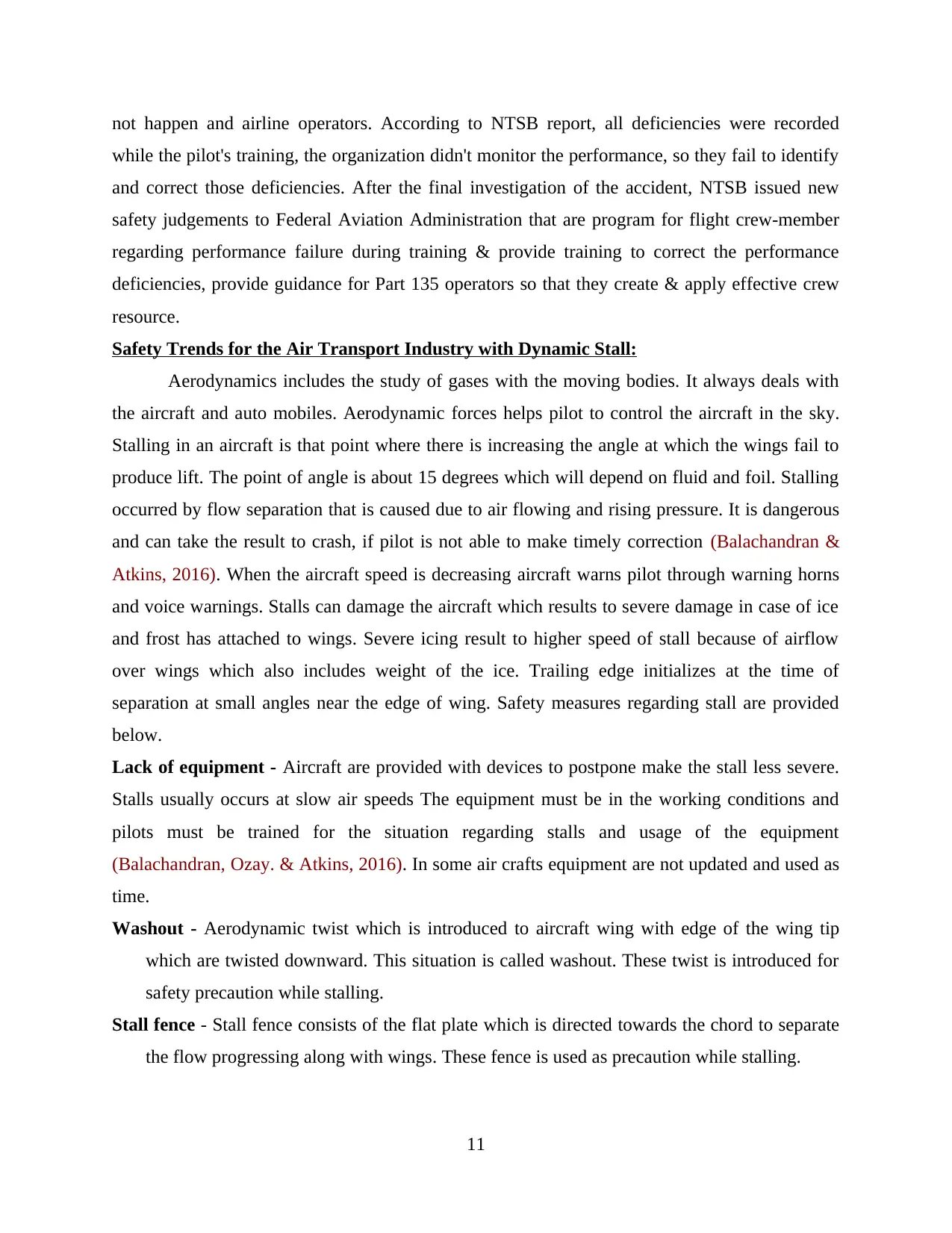
not happen and airline operators. According to NTSB report, all deficiencies were recorded
while the pilot's training, the organization didn't monitor the performance, so they fail to identify
and correct those deficiencies. After the final investigation of the accident, NTSB issued new
safety judgements to Federal Aviation Administration that are program for flight crew-member
regarding performance failure during training & provide training to correct the performance
deficiencies, provide guidance for Part 135 operators so that they create & apply effective crew
resource.
Safety Trends for the Air Transport Industry with Dynamic Stall:
Aerodynamics includes the study of gases with the moving bodies. It always deals with
the aircraft and auto mobiles. Aerodynamic forces helps pilot to control the aircraft in the sky.
Stalling in an aircraft is that point where there is increasing the angle at which the wings fail to
produce lift. The point of angle is about 15 degrees which will depend on fluid and foil. Stalling
occurred by flow separation that is caused due to air flowing and rising pressure. It is dangerous
and can take the result to crash, if pilot is not able to make timely correction (Balachandran &
Atkins, 2016). When the aircraft speed is decreasing aircraft warns pilot through warning horns
and voice warnings. Stalls can damage the aircraft which results to severe damage in case of ice
and frost has attached to wings. Severe icing result to higher speed of stall because of airflow
over wings which also includes weight of the ice. Trailing edge initializes at the time of
separation at small angles near the edge of wing. Safety measures regarding stall are provided
below.
Lack of equipment - Aircraft are provided with devices to postpone make the stall less severe.
Stalls usually occurs at slow air speeds The equipment must be in the working conditions and
pilots must be trained for the situation regarding stalls and usage of the equipment
(Balachandran, Ozay. & Atkins, 2016). In some air crafts equipment are not updated and used as
time.
Washout - Aerodynamic twist which is introduced to aircraft wing with edge of the wing tip
which are twisted downward. This situation is called washout. These twist is introduced for
safety precaution while stalling.
Stall fence - Stall fence consists of the flat plate which is directed towards the chord to separate
the flow progressing along with wings. These fence is used as precaution while stalling.
11
while the pilot's training, the organization didn't monitor the performance, so they fail to identify
and correct those deficiencies. After the final investigation of the accident, NTSB issued new
safety judgements to Federal Aviation Administration that are program for flight crew-member
regarding performance failure during training & provide training to correct the performance
deficiencies, provide guidance for Part 135 operators so that they create & apply effective crew
resource.
Safety Trends for the Air Transport Industry with Dynamic Stall:
Aerodynamics includes the study of gases with the moving bodies. It always deals with
the aircraft and auto mobiles. Aerodynamic forces helps pilot to control the aircraft in the sky.
Stalling in an aircraft is that point where there is increasing the angle at which the wings fail to
produce lift. The point of angle is about 15 degrees which will depend on fluid and foil. Stalling
occurred by flow separation that is caused due to air flowing and rising pressure. It is dangerous
and can take the result to crash, if pilot is not able to make timely correction (Balachandran &
Atkins, 2016). When the aircraft speed is decreasing aircraft warns pilot through warning horns
and voice warnings. Stalls can damage the aircraft which results to severe damage in case of ice
and frost has attached to wings. Severe icing result to higher speed of stall because of airflow
over wings which also includes weight of the ice. Trailing edge initializes at the time of
separation at small angles near the edge of wing. Safety measures regarding stall are provided
below.
Lack of equipment - Aircraft are provided with devices to postpone make the stall less severe.
Stalls usually occurs at slow air speeds The equipment must be in the working conditions and
pilots must be trained for the situation regarding stalls and usage of the equipment
(Balachandran, Ozay. & Atkins, 2016). In some air crafts equipment are not updated and used as
time.
Washout - Aerodynamic twist which is introduced to aircraft wing with edge of the wing tip
which are twisted downward. This situation is called washout. These twist is introduced for
safety precaution while stalling.
Stall fence - Stall fence consists of the flat plate which is directed towards the chord to separate
the flow progressing along with wings. These fence is used as precaution while stalling.
11
Paraphrase This Document
Need a fresh take? Get an instant paraphrase of this document with our AI Paraphraser
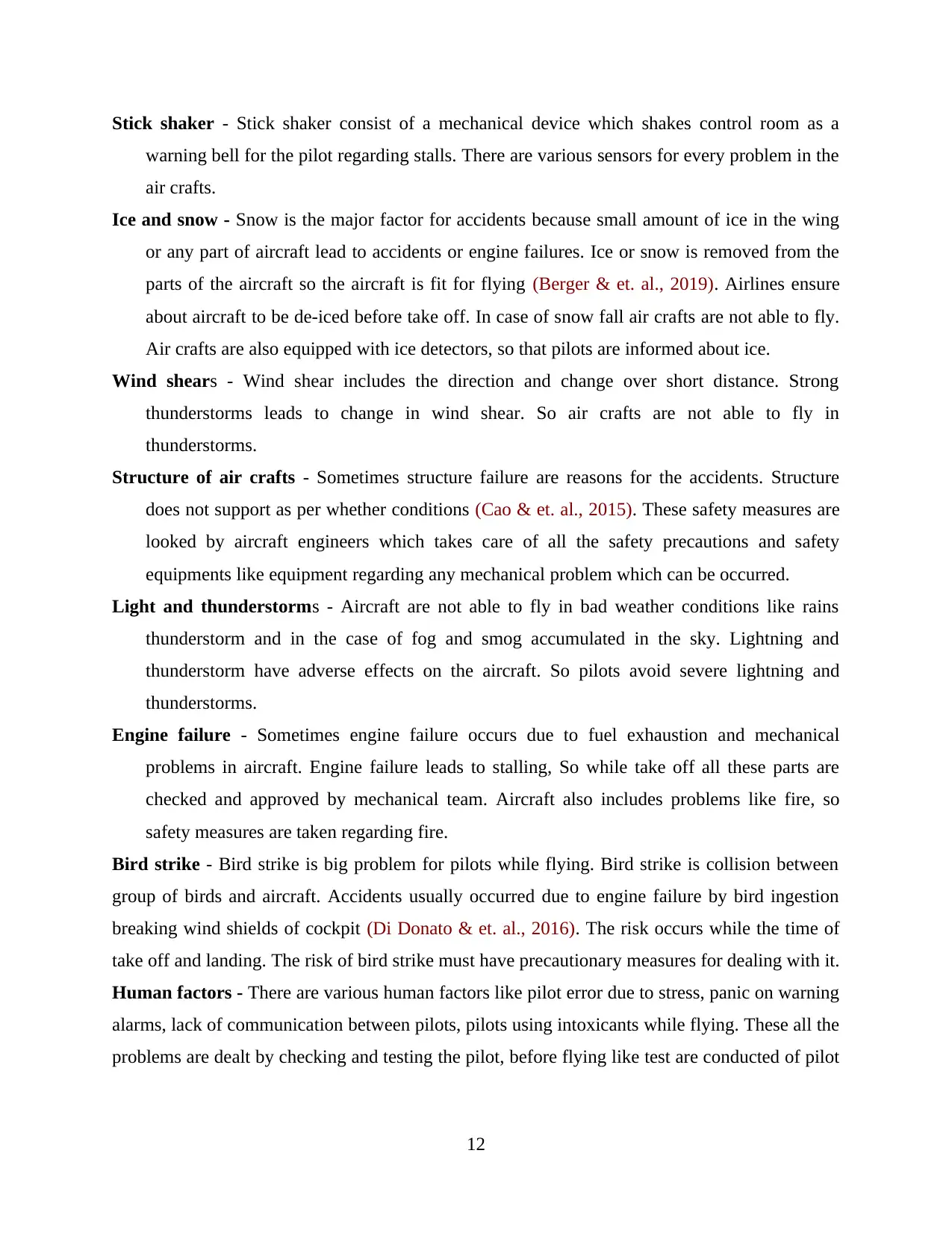
Stick shaker - Stick shaker consist of a mechanical device which shakes control room as a
warning bell for the pilot regarding stalls. There are various sensors for every problem in the
air crafts.
Ice and snow - Snow is the major factor for accidents because small amount of ice in the wing
or any part of aircraft lead to accidents or engine failures. Ice or snow is removed from the
parts of the aircraft so the aircraft is fit for flying (Berger & et. al., 2019). Airlines ensure
about aircraft to be de-iced before take off. In case of snow fall air crafts are not able to fly.
Air crafts are also equipped with ice detectors, so that pilots are informed about ice.
Wind shears - Wind shear includes the direction and change over short distance. Strong
thunderstorms leads to change in wind shear. So air crafts are not able to fly in
thunderstorms.
Structure of air crafts - Sometimes structure failure are reasons for the accidents. Structure
does not support as per whether conditions (Cao & et. al., 2015). These safety measures are
looked by aircraft engineers which takes care of all the safety precautions and safety
equipments like equipment regarding any mechanical problem which can be occurred.
Light and thunderstorms - Aircraft are not able to fly in bad weather conditions like rains
thunderstorm and in the case of fog and smog accumulated in the sky. Lightning and
thunderstorm have adverse effects on the aircraft. So pilots avoid severe lightning and
thunderstorms.
Engine failure - Sometimes engine failure occurs due to fuel exhaustion and mechanical
problems in aircraft. Engine failure leads to stalling, So while take off all these parts are
checked and approved by mechanical team. Aircraft also includes problems like fire, so
safety measures are taken regarding fire.
Bird strike - Bird strike is big problem for pilots while flying. Bird strike is collision between
group of birds and aircraft. Accidents usually occurred due to engine failure by bird ingestion
breaking wind shields of cockpit (Di Donato & et. al., 2016). The risk occurs while the time of
take off and landing. The risk of bird strike must have precautionary measures for dealing with it.
Human factors - There are various human factors like pilot error due to stress, panic on warning
alarms, lack of communication between pilots, pilots using intoxicants while flying. These all the
problems are dealt by checking and testing the pilot, before flying like test are conducted of pilot
12
warning bell for the pilot regarding stalls. There are various sensors for every problem in the
air crafts.
Ice and snow - Snow is the major factor for accidents because small amount of ice in the wing
or any part of aircraft lead to accidents or engine failures. Ice or snow is removed from the
parts of the aircraft so the aircraft is fit for flying (Berger & et. al., 2019). Airlines ensure
about aircraft to be de-iced before take off. In case of snow fall air crafts are not able to fly.
Air crafts are also equipped with ice detectors, so that pilots are informed about ice.
Wind shears - Wind shear includes the direction and change over short distance. Strong
thunderstorms leads to change in wind shear. So air crafts are not able to fly in
thunderstorms.
Structure of air crafts - Sometimes structure failure are reasons for the accidents. Structure
does not support as per whether conditions (Cao & et. al., 2015). These safety measures are
looked by aircraft engineers which takes care of all the safety precautions and safety
equipments like equipment regarding any mechanical problem which can be occurred.
Light and thunderstorms - Aircraft are not able to fly in bad weather conditions like rains
thunderstorm and in the case of fog and smog accumulated in the sky. Lightning and
thunderstorm have adverse effects on the aircraft. So pilots avoid severe lightning and
thunderstorms.
Engine failure - Sometimes engine failure occurs due to fuel exhaustion and mechanical
problems in aircraft. Engine failure leads to stalling, So while take off all these parts are
checked and approved by mechanical team. Aircraft also includes problems like fire, so
safety measures are taken regarding fire.
Bird strike - Bird strike is big problem for pilots while flying. Bird strike is collision between
group of birds and aircraft. Accidents usually occurred due to engine failure by bird ingestion
breaking wind shields of cockpit (Di Donato & et. al., 2016). The risk occurs while the time of
take off and landing. The risk of bird strike must have precautionary measures for dealing with it.
Human factors - There are various human factors like pilot error due to stress, panic on warning
alarms, lack of communication between pilots, pilots using intoxicants while flying. These all the
problems are dealt by checking and testing the pilot, before flying like test are conducted of pilot
12
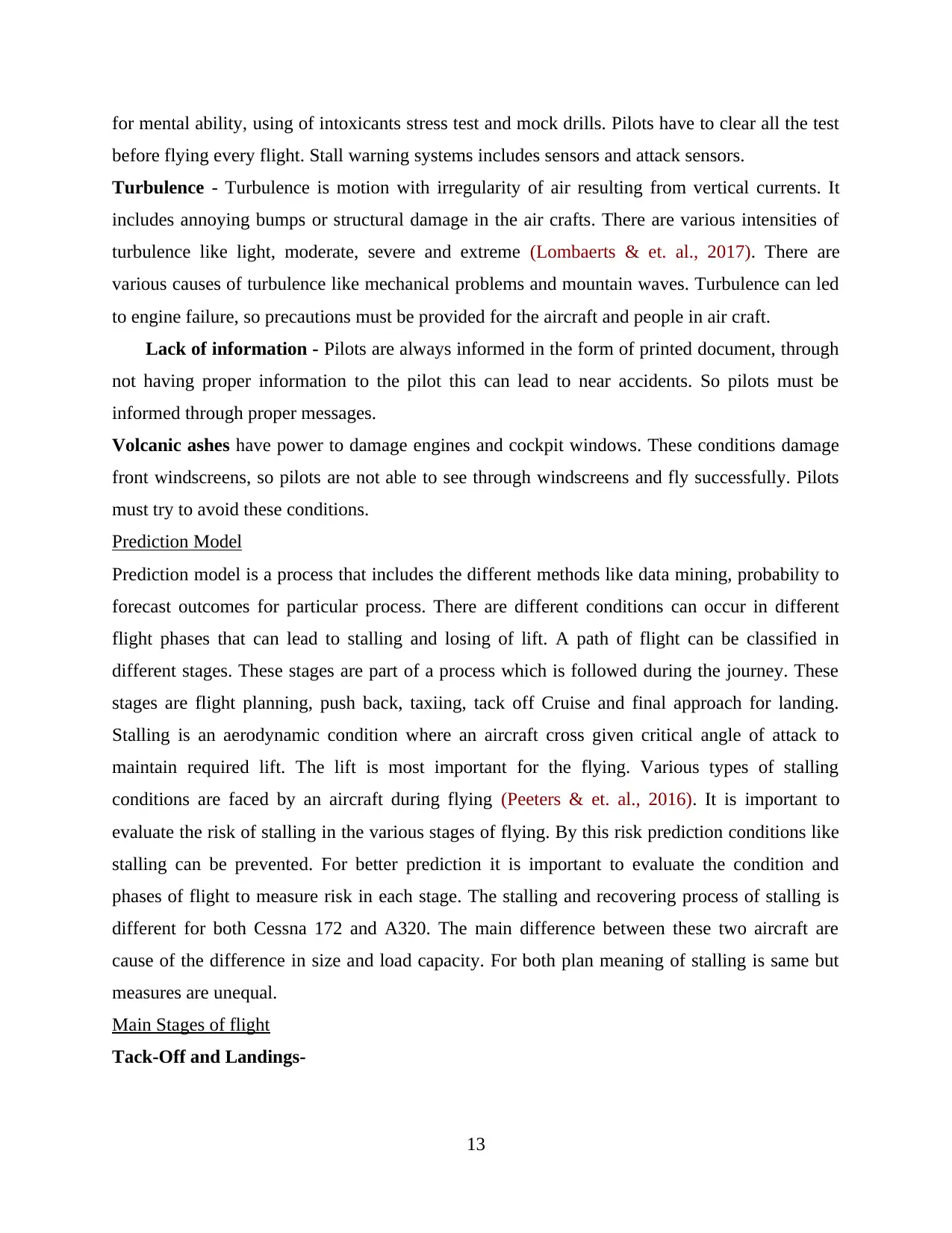
for mental ability, using of intoxicants stress test and mock drills. Pilots have to clear all the test
before flying every flight. Stall warning systems includes sensors and attack sensors.
Turbulence - Turbulence is motion with irregularity of air resulting from vertical currents. It
includes annoying bumps or structural damage in the air crafts. There are various intensities of
turbulence like light, moderate, severe and extreme (Lombaerts & et. al., 2017). There are
various causes of turbulence like mechanical problems and mountain waves. Turbulence can led
to engine failure, so precautions must be provided for the aircraft and people in air craft.
Lack of information - Pilots are always informed in the form of printed document, through
not having proper information to the pilot this can lead to near accidents. So pilots must be
informed through proper messages.
Volcanic ashes have power to damage engines and cockpit windows. These conditions damage
front windscreens, so pilots are not able to see through windscreens and fly successfully. Pilots
must try to avoid these conditions.
Prediction Model
Prediction model is a process that includes the different methods like data mining, probability to
forecast outcomes for particular process. There are different conditions can occur in different
flight phases that can lead to stalling and losing of lift. A path of flight can be classified in
different stages. These stages are part of a process which is followed during the journey. These
stages are flight planning, push back, taxiing, tack off Cruise and final approach for landing.
Stalling is an aerodynamic condition where an aircraft cross given critical angle of attack to
maintain required lift. The lift is most important for the flying. Various types of stalling
conditions are faced by an aircraft during flying (Peeters & et. al., 2016). It is important to
evaluate the risk of stalling in the various stages of flying. By this risk prediction conditions like
stalling can be prevented. For better prediction it is important to evaluate the condition and
phases of flight to measure risk in each stage. The stalling and recovering process of stalling is
different for both Cessna 172 and A320. The main difference between these two aircraft are
cause of the difference in size and load capacity. For both plan meaning of stalling is same but
measures are unequal.
Main Stages of flight
Tack-Off and Landings-
13
before flying every flight. Stall warning systems includes sensors and attack sensors.
Turbulence - Turbulence is motion with irregularity of air resulting from vertical currents. It
includes annoying bumps or structural damage in the air crafts. There are various intensities of
turbulence like light, moderate, severe and extreme (Lombaerts & et. al., 2017). There are
various causes of turbulence like mechanical problems and mountain waves. Turbulence can led
to engine failure, so precautions must be provided for the aircraft and people in air craft.
Lack of information - Pilots are always informed in the form of printed document, through
not having proper information to the pilot this can lead to near accidents. So pilots must be
informed through proper messages.
Volcanic ashes have power to damage engines and cockpit windows. These conditions damage
front windscreens, so pilots are not able to see through windscreens and fly successfully. Pilots
must try to avoid these conditions.
Prediction Model
Prediction model is a process that includes the different methods like data mining, probability to
forecast outcomes for particular process. There are different conditions can occur in different
flight phases that can lead to stalling and losing of lift. A path of flight can be classified in
different stages. These stages are part of a process which is followed during the journey. These
stages are flight planning, push back, taxiing, tack off Cruise and final approach for landing.
Stalling is an aerodynamic condition where an aircraft cross given critical angle of attack to
maintain required lift. The lift is most important for the flying. Various types of stalling
conditions are faced by an aircraft during flying (Peeters & et. al., 2016). It is important to
evaluate the risk of stalling in the various stages of flying. By this risk prediction conditions like
stalling can be prevented. For better prediction it is important to evaluate the condition and
phases of flight to measure risk in each stage. The stalling and recovering process of stalling is
different for both Cessna 172 and A320. The main difference between these two aircraft are
cause of the difference in size and load capacity. For both plan meaning of stalling is same but
measures are unequal.
Main Stages of flight
Tack-Off and Landings-
13
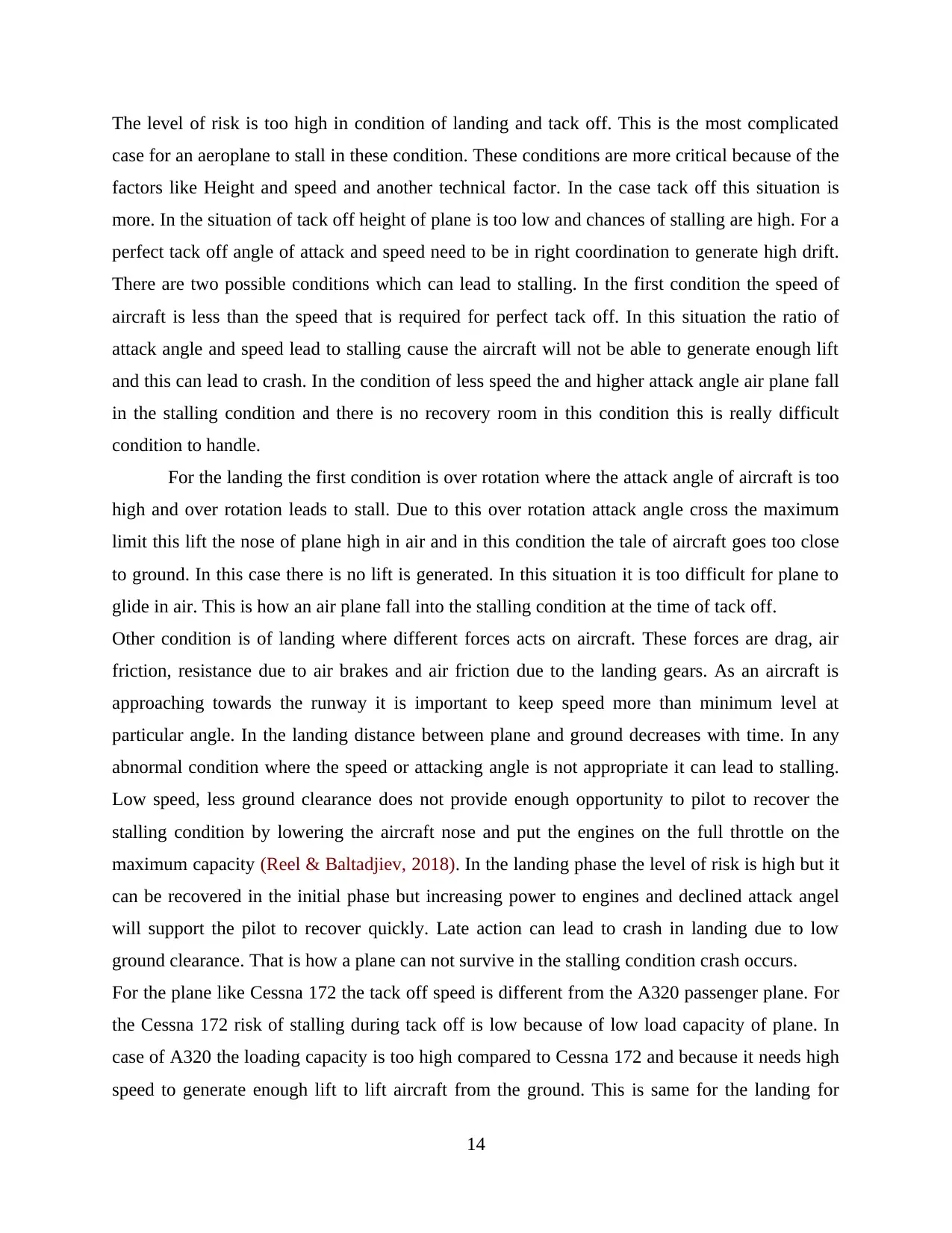
The level of risk is too high in condition of landing and tack off. This is the most complicated
case for an aeroplane to stall in these condition. These conditions are more critical because of the
factors like Height and speed and another technical factor. In the case tack off this situation is
more. In the situation of tack off height of plane is too low and chances of stalling are high. For a
perfect tack off angle of attack and speed need to be in right coordination to generate high drift.
There are two possible conditions which can lead to stalling. In the first condition the speed of
aircraft is less than the speed that is required for perfect tack off. In this situation the ratio of
attack angle and speed lead to stalling cause the aircraft will not be able to generate enough lift
and this can lead to crash. In the condition of less speed the and higher attack angle air plane fall
in the stalling condition and there is no recovery room in this condition this is really difficult
condition to handle.
For the landing the first condition is over rotation where the attack angle of aircraft is too
high and over rotation leads to stall. Due to this over rotation attack angle cross the maximum
limit this lift the nose of plane high in air and in this condition the tale of aircraft goes too close
to ground. In this case there is no lift is generated. In this situation it is too difficult for plane to
glide in air. This is how an air plane fall into the stalling condition at the time of tack off.
Other condition is of landing where different forces acts on aircraft. These forces are drag, air
friction, resistance due to air brakes and air friction due to the landing gears. As an aircraft is
approaching towards the runway it is important to keep speed more than minimum level at
particular angle. In the landing distance between plane and ground decreases with time. In any
abnormal condition where the speed or attacking angle is not appropriate it can lead to stalling.
Low speed, less ground clearance does not provide enough opportunity to pilot to recover the
stalling condition by lowering the aircraft nose and put the engines on the full throttle on the
maximum capacity (Reel & Baltadjiev, 2018). In the landing phase the level of risk is high but it
can be recovered in the initial phase but increasing power to engines and declined attack angel
will support the pilot to recover quickly. Late action can lead to crash in landing due to low
ground clearance. That is how a plane can not survive in the stalling condition crash occurs.
For the plane like Cessna 172 the tack off speed is different from the A320 passenger plane. For
the Cessna 172 risk of stalling during tack off is low because of low load capacity of plane. In
case of A320 the loading capacity is too high compared to Cessna 172 and because it needs high
speed to generate enough lift to lift aircraft from the ground. This is same for the landing for
14
case for an aeroplane to stall in these condition. These conditions are more critical because of the
factors like Height and speed and another technical factor. In the case tack off this situation is
more. In the situation of tack off height of plane is too low and chances of stalling are high. For a
perfect tack off angle of attack and speed need to be in right coordination to generate high drift.
There are two possible conditions which can lead to stalling. In the first condition the speed of
aircraft is less than the speed that is required for perfect tack off. In this situation the ratio of
attack angle and speed lead to stalling cause the aircraft will not be able to generate enough lift
and this can lead to crash. In the condition of less speed the and higher attack angle air plane fall
in the stalling condition and there is no recovery room in this condition this is really difficult
condition to handle.
For the landing the first condition is over rotation where the attack angle of aircraft is too
high and over rotation leads to stall. Due to this over rotation attack angle cross the maximum
limit this lift the nose of plane high in air and in this condition the tale of aircraft goes too close
to ground. In this case there is no lift is generated. In this situation it is too difficult for plane to
glide in air. This is how an air plane fall into the stalling condition at the time of tack off.
Other condition is of landing where different forces acts on aircraft. These forces are drag, air
friction, resistance due to air brakes and air friction due to the landing gears. As an aircraft is
approaching towards the runway it is important to keep speed more than minimum level at
particular angle. In the landing distance between plane and ground decreases with time. In any
abnormal condition where the speed or attacking angle is not appropriate it can lead to stalling.
Low speed, less ground clearance does not provide enough opportunity to pilot to recover the
stalling condition by lowering the aircraft nose and put the engines on the full throttle on the
maximum capacity (Reel & Baltadjiev, 2018). In the landing phase the level of risk is high but it
can be recovered in the initial phase but increasing power to engines and declined attack angel
will support the pilot to recover quickly. Late action can lead to crash in landing due to low
ground clearance. That is how a plane can not survive in the stalling condition crash occurs.
For the plane like Cessna 172 the tack off speed is different from the A320 passenger plane. For
the Cessna 172 risk of stalling during tack off is low because of low load capacity of plane. In
case of A320 the loading capacity is too high compared to Cessna 172 and because it needs high
speed to generate enough lift to lift aircraft from the ground. This is same for the landing for
14
Secure Best Marks with AI Grader
Need help grading? Try our AI Grader for instant feedback on your assignments.
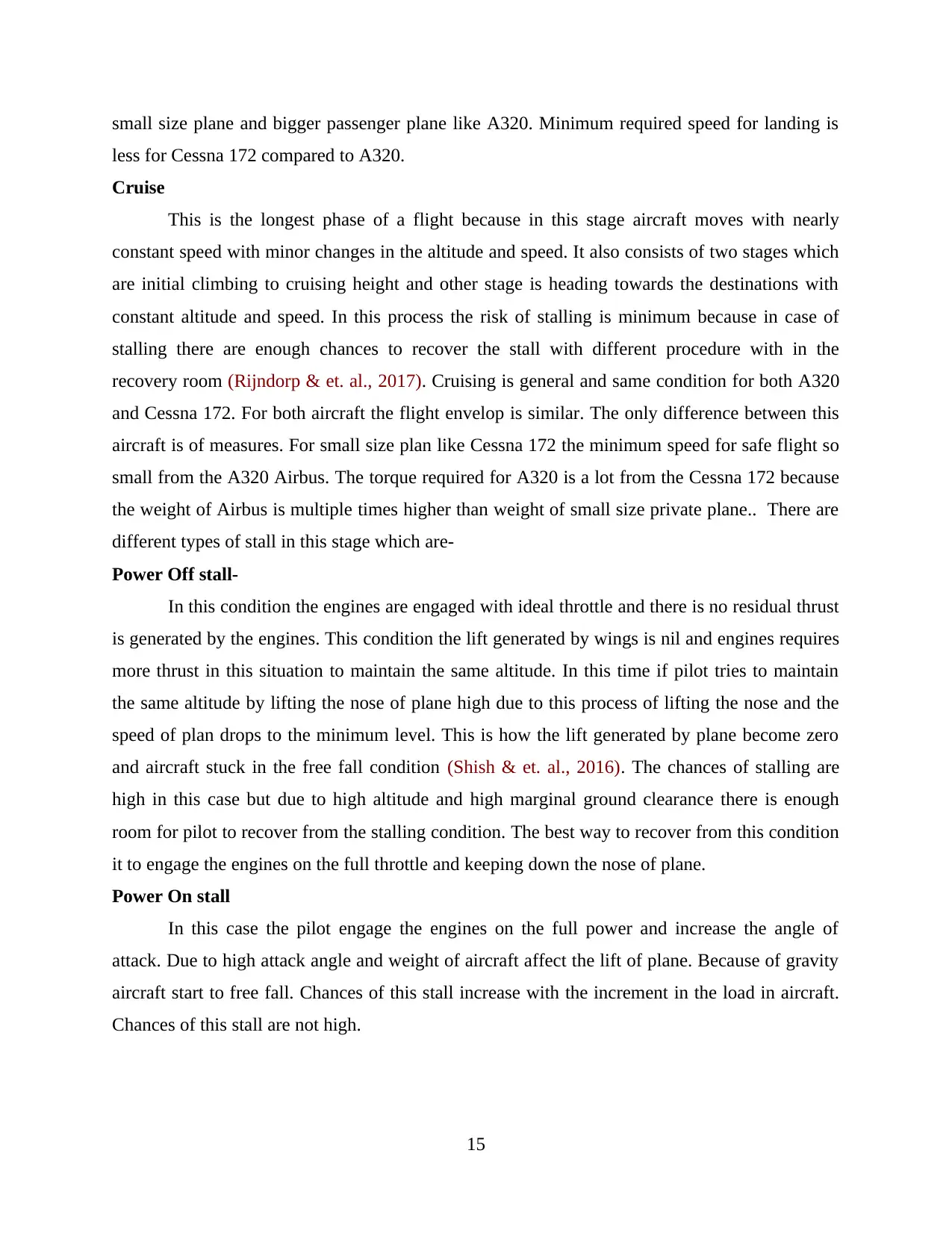
small size plane and bigger passenger plane like A320. Minimum required speed for landing is
less for Cessna 172 compared to A320.
Cruise
This is the longest phase of a flight because in this stage aircraft moves with nearly
constant speed with minor changes in the altitude and speed. It also consists of two stages which
are initial climbing to cruising height and other stage is heading towards the destinations with
constant altitude and speed. In this process the risk of stalling is minimum because in case of
stalling there are enough chances to recover the stall with different procedure with in the
recovery room (Rijndorp & et. al., 2017). Cruising is general and same condition for both A320
and Cessna 172. For both aircraft the flight envelop is similar. The only difference between this
aircraft is of measures. For small size plan like Cessna 172 the minimum speed for safe flight so
small from the A320 Airbus. The torque required for A320 is a lot from the Cessna 172 because
the weight of Airbus is multiple times higher than weight of small size private plane.. There are
different types of stall in this stage which are-
Power Off stall-
In this condition the engines are engaged with ideal throttle and there is no residual thrust
is generated by the engines. This condition the lift generated by wings is nil and engines requires
more thrust in this situation to maintain the same altitude. In this time if pilot tries to maintain
the same altitude by lifting the nose of plane high due to this process of lifting the nose and the
speed of plan drops to the minimum level. This is how the lift generated by plane become zero
and aircraft stuck in the free fall condition (Shish & et. al., 2016). The chances of stalling are
high in this case but due to high altitude and high marginal ground clearance there is enough
room for pilot to recover from the stalling condition. The best way to recover from this condition
it to engage the engines on the full throttle and keeping down the nose of plane.
Power On stall
In this case the pilot engage the engines on the full power and increase the angle of
attack. Due to high attack angle and weight of aircraft affect the lift of plane. Because of gravity
aircraft start to free fall. Chances of this stall increase with the increment in the load in aircraft.
Chances of this stall are not high.
15
less for Cessna 172 compared to A320.
Cruise
This is the longest phase of a flight because in this stage aircraft moves with nearly
constant speed with minor changes in the altitude and speed. It also consists of two stages which
are initial climbing to cruising height and other stage is heading towards the destinations with
constant altitude and speed. In this process the risk of stalling is minimum because in case of
stalling there are enough chances to recover the stall with different procedure with in the
recovery room (Rijndorp & et. al., 2017). Cruising is general and same condition for both A320
and Cessna 172. For both aircraft the flight envelop is similar. The only difference between this
aircraft is of measures. For small size plan like Cessna 172 the minimum speed for safe flight so
small from the A320 Airbus. The torque required for A320 is a lot from the Cessna 172 because
the weight of Airbus is multiple times higher than weight of small size private plane.. There are
different types of stall in this stage which are-
Power Off stall-
In this condition the engines are engaged with ideal throttle and there is no residual thrust
is generated by the engines. This condition the lift generated by wings is nil and engines requires
more thrust in this situation to maintain the same altitude. In this time if pilot tries to maintain
the same altitude by lifting the nose of plane high due to this process of lifting the nose and the
speed of plan drops to the minimum level. This is how the lift generated by plane become zero
and aircraft stuck in the free fall condition (Shish & et. al., 2016). The chances of stalling are
high in this case but due to high altitude and high marginal ground clearance there is enough
room for pilot to recover from the stalling condition. The best way to recover from this condition
it to engage the engines on the full throttle and keeping down the nose of plane.
Power On stall
In this case the pilot engage the engines on the full power and increase the angle of
attack. Due to high attack angle and weight of aircraft affect the lift of plane. Because of gravity
aircraft start to free fall. Chances of this stall increase with the increment in the load in aircraft.
Chances of this stall are not high.
15
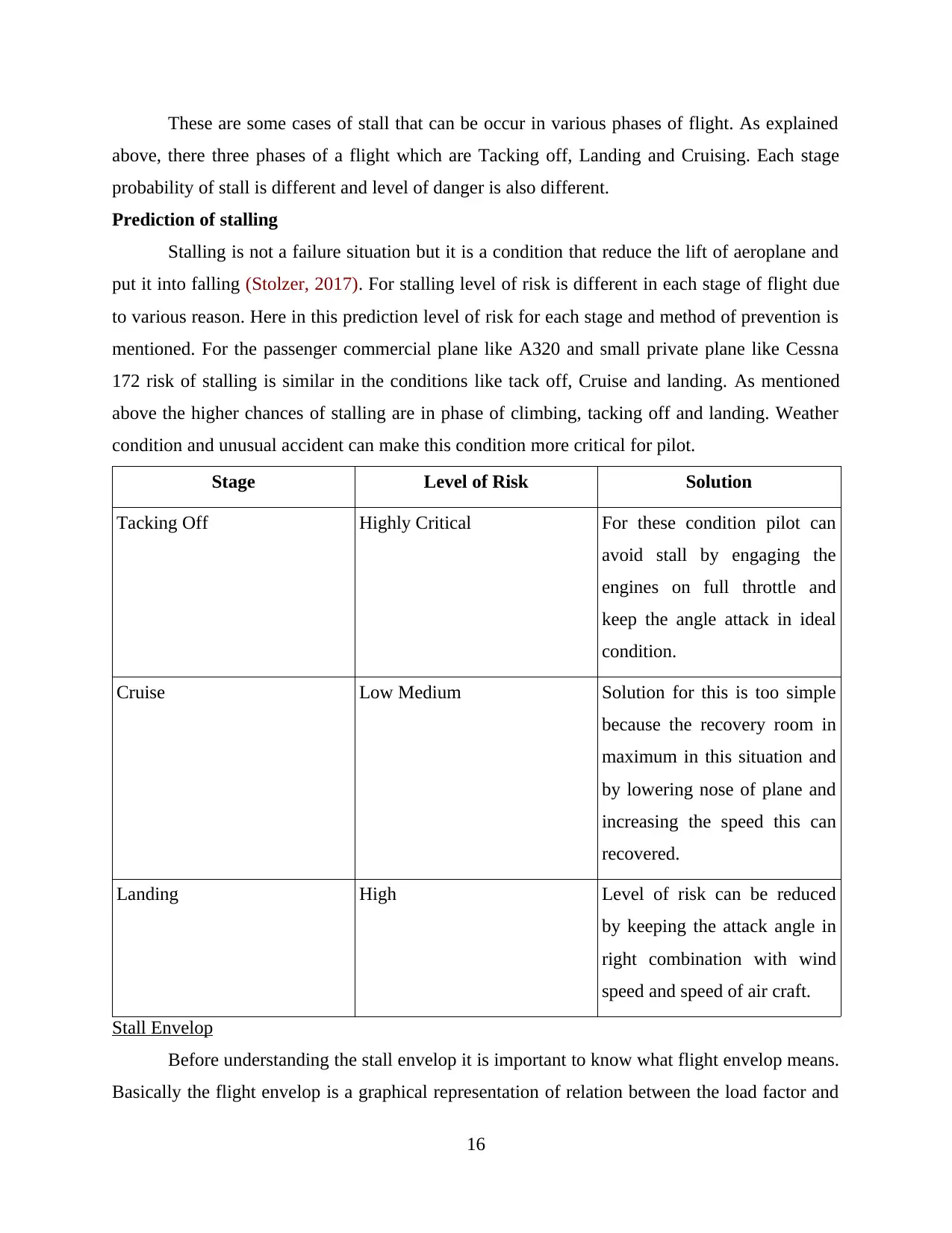
These are some cases of stall that can be occur in various phases of flight. As explained
above, there three phases of a flight which are Tacking off, Landing and Cruising. Each stage
probability of stall is different and level of danger is also different.
Prediction of stalling
Stalling is not a failure situation but it is a condition that reduce the lift of aeroplane and
put it into falling (Stolzer, 2017). For stalling level of risk is different in each stage of flight due
to various reason. Here in this prediction level of risk for each stage and method of prevention is
mentioned. For the passenger commercial plane like A320 and small private plane like Cessna
172 risk of stalling is similar in the conditions like tack off, Cruise and landing. As mentioned
above the higher chances of stalling are in phase of climbing, tacking off and landing. Weather
condition and unusual accident can make this condition more critical for pilot.
Stage Level of Risk Solution
Tacking Off Highly Critical For these condition pilot can
avoid stall by engaging the
engines on full throttle and
keep the angle attack in ideal
condition.
Cruise Low Medium Solution for this is too simple
because the recovery room in
maximum in this situation and
by lowering nose of plane and
increasing the speed this can
recovered.
Landing High Level of risk can be reduced
by keeping the attack angle in
right combination with wind
speed and speed of air craft.
Stall Envelop
Before understanding the stall envelop it is important to know what flight envelop means.
Basically the flight envelop is a graphical representation of relation between the load factor and
16
above, there three phases of a flight which are Tacking off, Landing and Cruising. Each stage
probability of stall is different and level of danger is also different.
Prediction of stalling
Stalling is not a failure situation but it is a condition that reduce the lift of aeroplane and
put it into falling (Stolzer, 2017). For stalling level of risk is different in each stage of flight due
to various reason. Here in this prediction level of risk for each stage and method of prevention is
mentioned. For the passenger commercial plane like A320 and small private plane like Cessna
172 risk of stalling is similar in the conditions like tack off, Cruise and landing. As mentioned
above the higher chances of stalling are in phase of climbing, tacking off and landing. Weather
condition and unusual accident can make this condition more critical for pilot.
Stage Level of Risk Solution
Tacking Off Highly Critical For these condition pilot can
avoid stall by engaging the
engines on full throttle and
keep the angle attack in ideal
condition.
Cruise Low Medium Solution for this is too simple
because the recovery room in
maximum in this situation and
by lowering nose of plane and
increasing the speed this can
recovered.
Landing High Level of risk can be reduced
by keeping the attack angle in
right combination with wind
speed and speed of air craft.
Stall Envelop
Before understanding the stall envelop it is important to know what flight envelop means.
Basically the flight envelop is a graphical representation of relation between the load factor and
16
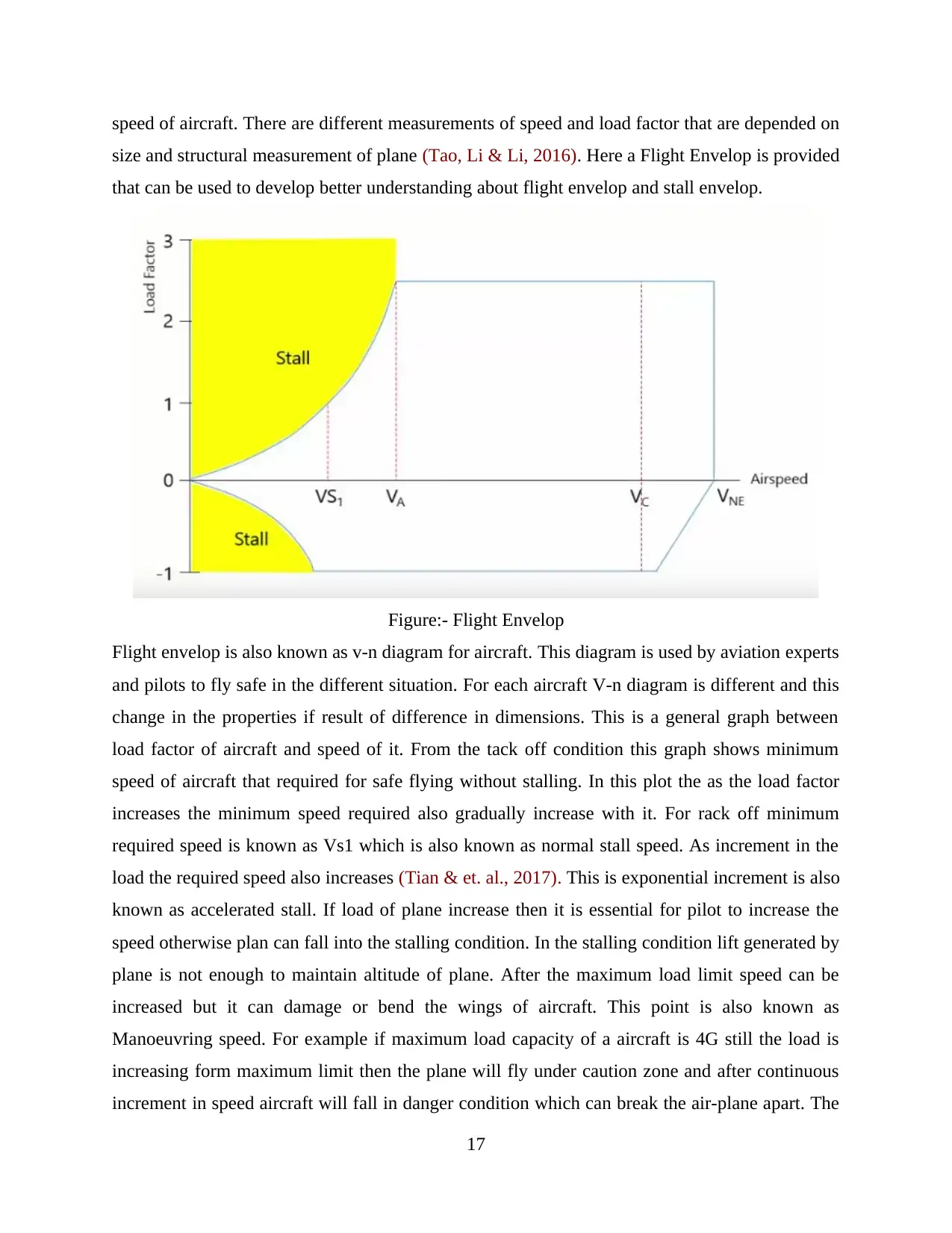
speed of aircraft. There are different measurements of speed and load factor that are depended on
size and structural measurement of plane (Tao, Li & Li, 2016). Here a Flight Envelop is provided
that can be used to develop better understanding about flight envelop and stall envelop.
Figure:- Flight Envelop
Flight envelop is also known as v-n diagram for aircraft. This diagram is used by aviation experts
and pilots to fly safe in the different situation. For each aircraft V-n diagram is different and this
change in the properties if result of difference in dimensions. This is a general graph between
load factor of aircraft and speed of it. From the tack off condition this graph shows minimum
speed of aircraft that required for safe flying without stalling. In this plot the as the load factor
increases the minimum speed required also gradually increase with it. For rack off minimum
required speed is known as Vs1 which is also known as normal stall speed. As increment in the
load the required speed also increases (Tian & et. al., 2017). This is exponential increment is also
known as accelerated stall. If load of plane increase then it is essential for pilot to increase the
speed otherwise plan can fall into the stalling condition. In the stalling condition lift generated by
plane is not enough to maintain altitude of plane. After the maximum load limit speed can be
increased but it can damage or bend the wings of aircraft. This point is also known as
Manoeuvring speed. For example if maximum load capacity of a aircraft is 4G still the load is
increasing form maximum limit then the plane will fly under caution zone and after continuous
increment in speed aircraft will fall in danger condition which can break the air-plane apart. The
17
size and structural measurement of plane (Tao, Li & Li, 2016). Here a Flight Envelop is provided
that can be used to develop better understanding about flight envelop and stall envelop.
Figure:- Flight Envelop
Flight envelop is also known as v-n diagram for aircraft. This diagram is used by aviation experts
and pilots to fly safe in the different situation. For each aircraft V-n diagram is different and this
change in the properties if result of difference in dimensions. This is a general graph between
load factor of aircraft and speed of it. From the tack off condition this graph shows minimum
speed of aircraft that required for safe flying without stalling. In this plot the as the load factor
increases the minimum speed required also gradually increase with it. For rack off minimum
required speed is known as Vs1 which is also known as normal stall speed. As increment in the
load the required speed also increases (Tian & et. al., 2017). This is exponential increment is also
known as accelerated stall. If load of plane increase then it is essential for pilot to increase the
speed otherwise plan can fall into the stalling condition. In the stalling condition lift generated by
plane is not enough to maintain altitude of plane. After the maximum load limit speed can be
increased but it can damage or bend the wings of aircraft. This point is also known as
Manoeuvring speed. For example if maximum load capacity of a aircraft is 4G still the load is
increasing form maximum limit then the plane will fly under caution zone and after continuous
increment in speed aircraft will fall in danger condition which can break the air-plane apart. The
17
Paraphrase This Document
Need a fresh take? Get an instant paraphrase of this document with our AI Paraphraser
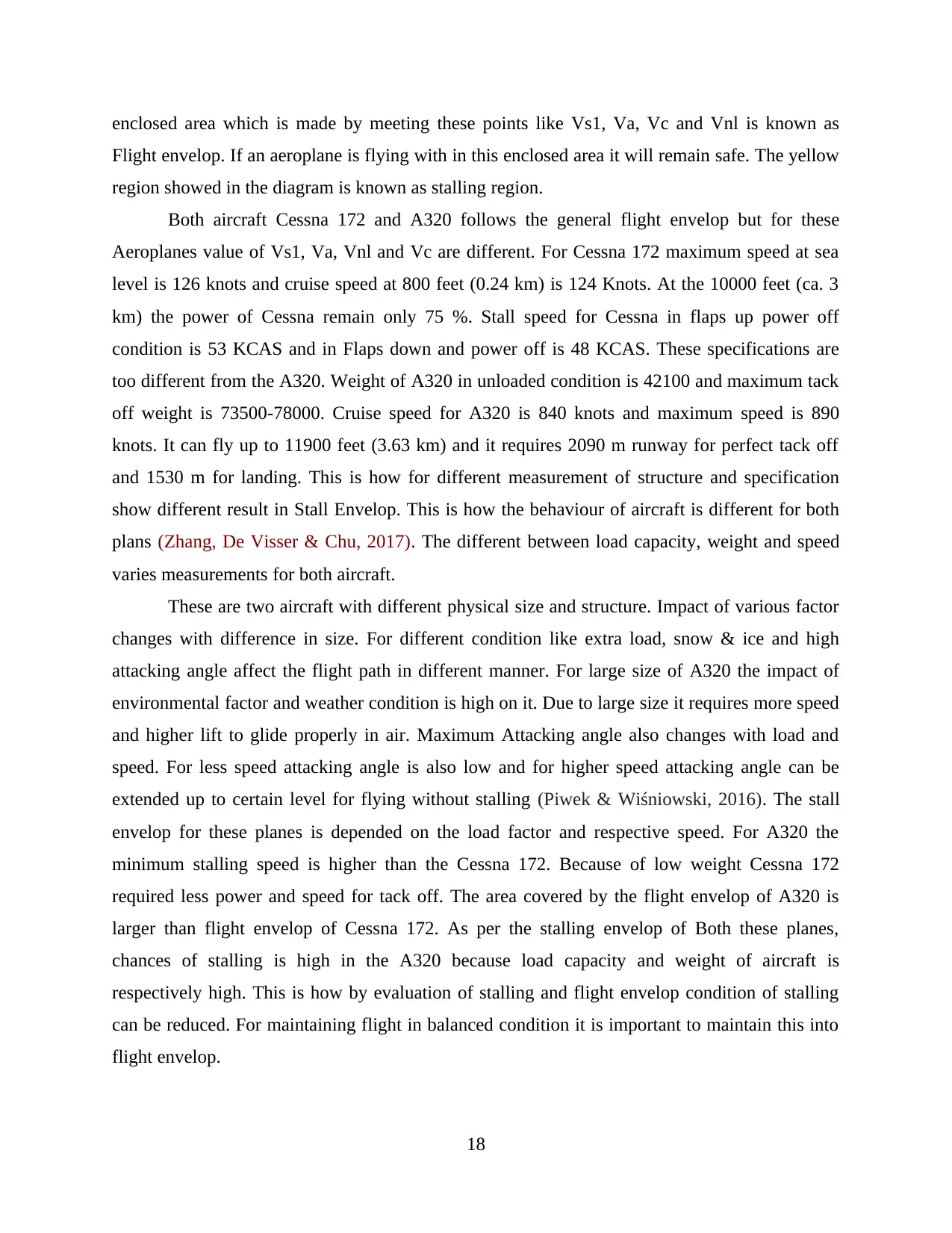
enclosed area which is made by meeting these points like Vs1, Va, Vc and Vnl is known as
Flight envelop. If an aeroplane is flying with in this enclosed area it will remain safe. The yellow
region showed in the diagram is known as stalling region.
Both aircraft Cessna 172 and A320 follows the general flight envelop but for these
Aeroplanes value of Vs1, Va, Vnl and Vc are different. For Cessna 172 maximum speed at sea
level is 126 knots and cruise speed at 800 feet (0.24 km) is 124 Knots. At the 10000 feet (ca. 3
km) the power of Cessna remain only 75 %. Stall speed for Cessna in flaps up power off
condition is 53 KCAS and in Flaps down and power off is 48 KCAS. These specifications are
too different from the A320. Weight of A320 in unloaded condition is 42100 and maximum tack
off weight is 73500-78000. Cruise speed for A320 is 840 knots and maximum speed is 890
knots. It can fly up to 11900 feet (3.63 km) and it requires 2090 m runway for perfect tack off
and 1530 m for landing. This is how for different measurement of structure and specification
show different result in Stall Envelop. This is how the behaviour of aircraft is different for both
plans (Zhang, De Visser & Chu, 2017). The different between load capacity, weight and speed
varies measurements for both aircraft.
These are two aircraft with different physical size and structure. Impact of various factor
changes with difference in size. For different condition like extra load, snow & ice and high
attacking angle affect the flight path in different manner. For large size of A320 the impact of
environmental factor and weather condition is high on it. Due to large size it requires more speed
and higher lift to glide properly in air. Maximum Attacking angle also changes with load and
speed. For less speed attacking angle is also low and for higher speed attacking angle can be
extended up to certain level for flying without stalling (Piwek & Wiśniowski, 2016). The stall
envelop for these planes is depended on the load factor and respective speed. For A320 the
minimum stalling speed is higher than the Cessna 172. Because of low weight Cessna 172
required less power and speed for tack off. The area covered by the flight envelop of A320 is
larger than flight envelop of Cessna 172. As per the stalling envelop of Both these planes,
chances of stalling is high in the A320 because load capacity and weight of aircraft is
respectively high. This is how by evaluation of stalling and flight envelop condition of stalling
can be reduced. For maintaining flight in balanced condition it is important to maintain this into
flight envelop.
18
Flight envelop. If an aeroplane is flying with in this enclosed area it will remain safe. The yellow
region showed in the diagram is known as stalling region.
Both aircraft Cessna 172 and A320 follows the general flight envelop but for these
Aeroplanes value of Vs1, Va, Vnl and Vc are different. For Cessna 172 maximum speed at sea
level is 126 knots and cruise speed at 800 feet (0.24 km) is 124 Knots. At the 10000 feet (ca. 3
km) the power of Cessna remain only 75 %. Stall speed for Cessna in flaps up power off
condition is 53 KCAS and in Flaps down and power off is 48 KCAS. These specifications are
too different from the A320. Weight of A320 in unloaded condition is 42100 and maximum tack
off weight is 73500-78000. Cruise speed for A320 is 840 knots and maximum speed is 890
knots. It can fly up to 11900 feet (3.63 km) and it requires 2090 m runway for perfect tack off
and 1530 m for landing. This is how for different measurement of structure and specification
show different result in Stall Envelop. This is how the behaviour of aircraft is different for both
plans (Zhang, De Visser & Chu, 2017). The different between load capacity, weight and speed
varies measurements for both aircraft.
These are two aircraft with different physical size and structure. Impact of various factor
changes with difference in size. For different condition like extra load, snow & ice and high
attacking angle affect the flight path in different manner. For large size of A320 the impact of
environmental factor and weather condition is high on it. Due to large size it requires more speed
and higher lift to glide properly in air. Maximum Attacking angle also changes with load and
speed. For less speed attacking angle is also low and for higher speed attacking angle can be
extended up to certain level for flying without stalling (Piwek & Wiśniowski, 2016). The stall
envelop for these planes is depended on the load factor and respective speed. For A320 the
minimum stalling speed is higher than the Cessna 172. Because of low weight Cessna 172
required less power and speed for tack off. The area covered by the flight envelop of A320 is
larger than flight envelop of Cessna 172. As per the stalling envelop of Both these planes,
chances of stalling is high in the A320 because load capacity and weight of aircraft is
respectively high. This is how by evaluation of stalling and flight envelop condition of stalling
can be reduced. For maintaining flight in balanced condition it is important to maintain this into
flight envelop.
18
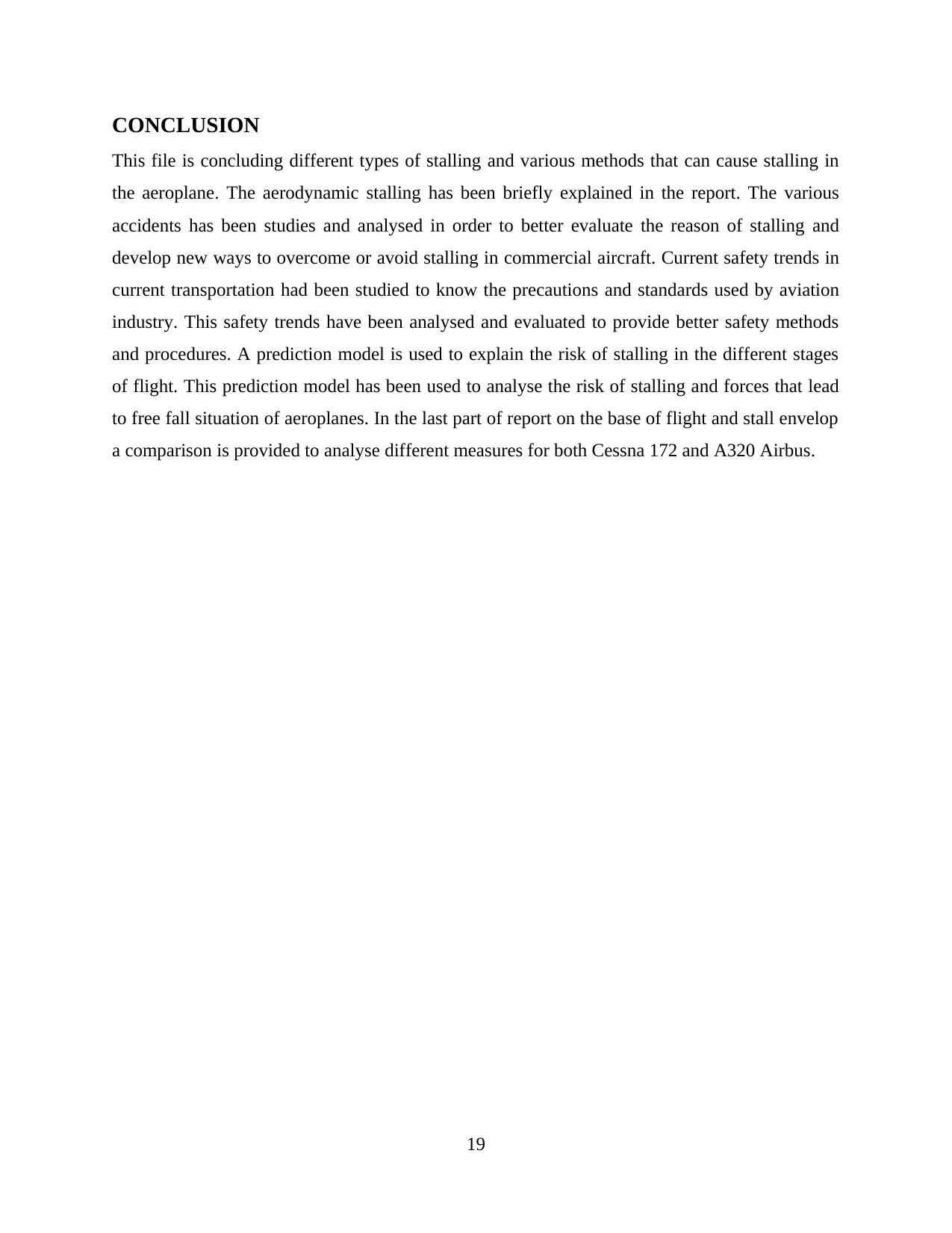
CONCLUSION
This file is concluding different types of stalling and various methods that can cause stalling in
the aeroplane. The aerodynamic stalling has been briefly explained in the report. The various
accidents has been studies and analysed in order to better evaluate the reason of stalling and
develop new ways to overcome or avoid stalling in commercial aircraft. Current safety trends in
current transportation had been studied to know the precautions and standards used by aviation
industry. This safety trends have been analysed and evaluated to provide better safety methods
and procedures. A prediction model is used to explain the risk of stalling in the different stages
of flight. This prediction model has been used to analyse the risk of stalling and forces that lead
to free fall situation of aeroplanes. In the last part of report on the base of flight and stall envelop
a comparison is provided to analyse different measures for both Cessna 172 and A320 Airbus.
19
This file is concluding different types of stalling and various methods that can cause stalling in
the aeroplane. The aerodynamic stalling has been briefly explained in the report. The various
accidents has been studies and analysed in order to better evaluate the reason of stalling and
develop new ways to overcome or avoid stalling in commercial aircraft. Current safety trends in
current transportation had been studied to know the precautions and standards used by aviation
industry. This safety trends have been analysed and evaluated to provide better safety methods
and procedures. A prediction model is used to explain the risk of stalling in the different stages
of flight. This prediction model has been used to analyse the risk of stalling and forces that lead
to free fall situation of aeroplanes. In the last part of report on the base of flight and stall envelop
a comparison is provided to analyse different measures for both Cessna 172 and A320 Airbus.
19
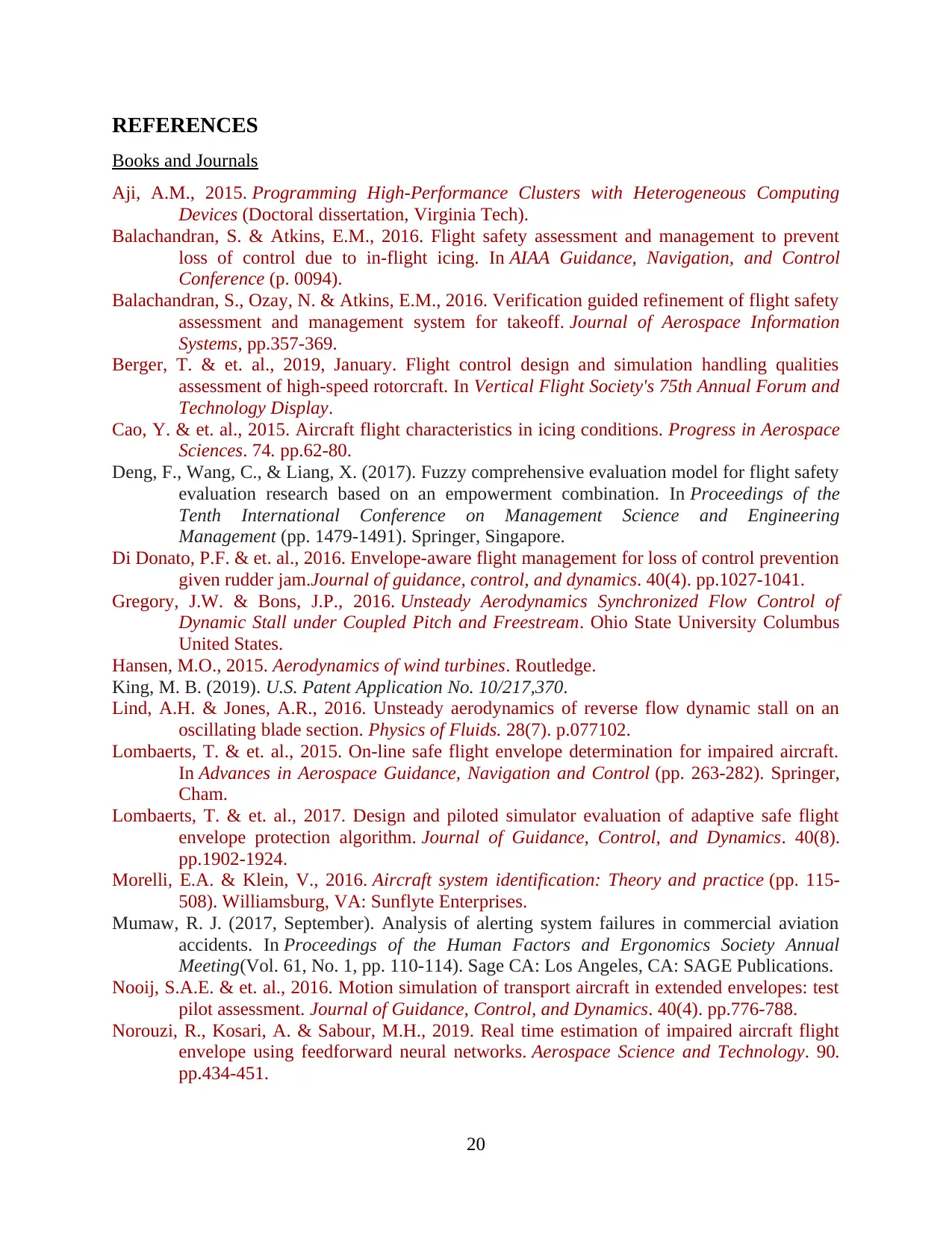
REFERENCES
Books and Journals
Aji, A.M., 2015. Programming High-Performance Clusters with Heterogeneous Computing
Devices (Doctoral dissertation, Virginia Tech).
Balachandran, S. & Atkins, E.M., 2016. Flight safety assessment and management to prevent
loss of control due to in-flight icing. In AIAA Guidance, Navigation, and Control
Conference (p. 0094).
Balachandran, S., Ozay, N. & Atkins, E.M., 2016. Verification guided refinement of flight safety
assessment and management system for takeoff. Journal of Aerospace Information
Systems, pp.357-369.
Berger, T. & et. al., 2019, January. Flight control design and simulation handling qualities
assessment of high-speed rotorcraft. In Vertical Flight Society's 75th Annual Forum and
Technology Display.
Cao, Y. & et. al., 2015. Aircraft flight characteristics in icing conditions. Progress in Aerospace
Sciences. 74. pp.62-80.
Deng, F., Wang, C., & Liang, X. (2017). Fuzzy comprehensive evaluation model for flight safety
evaluation research based on an empowerment combination. In Proceedings of the
Tenth International Conference on Management Science and Engineering
Management (pp. 1479-1491). Springer, Singapore.
Di Donato, P.F. & et. al., 2016. Envelope-aware flight management for loss of control prevention
given rudder jam.Journal of guidance, control, and dynamics. 40(4). pp.1027-1041.
Gregory, J.W. & Bons, J.P., 2016. Unsteady Aerodynamics Synchronized Flow Control of
Dynamic Stall under Coupled Pitch and Freestream. Ohio State University Columbus
United States.
Hansen, M.O., 2015. Aerodynamics of wind turbines. Routledge.
King, M. B. (2019). U.S. Patent Application No. 10/217,370.
Lind, A.H. & Jones, A.R., 2016. Unsteady aerodynamics of reverse flow dynamic stall on an
oscillating blade section. Physics of Fluids. 28(7). p.077102.
Lombaerts, T. & et. al., 2015. On-line safe flight envelope determination for impaired aircraft.
In Advances in Aerospace Guidance, Navigation and Control (pp. 263-282). Springer,
Cham.
Lombaerts, T. & et. al., 2017. Design and piloted simulator evaluation of adaptive safe flight
envelope protection algorithm. Journal of Guidance, Control, and Dynamics. 40(8).
pp.1902-1924.
Morelli, E.A. & Klein, V., 2016. Aircraft system identification: Theory and practice (pp. 115-
508). Williamsburg, VA: Sunflyte Enterprises.
Mumaw, R. J. (2017, September). Analysis of alerting system failures in commercial aviation
accidents. In Proceedings of the Human Factors and Ergonomics Society Annual
Meeting(Vol. 61, No. 1, pp. 110-114). Sage CA: Los Angeles, CA: SAGE Publications.
Nooij, S.A.E. & et. al., 2016. Motion simulation of transport aircraft in extended envelopes: test
pilot assessment. Journal of Guidance, Control, and Dynamics. 40(4). pp.776-788.
Norouzi, R., Kosari, A. & Sabour, M.H., 2019. Real time estimation of impaired aircraft flight
envelope using feedforward neural networks. Aerospace Science and Technology. 90.
pp.434-451.
20
Books and Journals
Aji, A.M., 2015. Programming High-Performance Clusters with Heterogeneous Computing
Devices (Doctoral dissertation, Virginia Tech).
Balachandran, S. & Atkins, E.M., 2016. Flight safety assessment and management to prevent
loss of control due to in-flight icing. In AIAA Guidance, Navigation, and Control
Conference (p. 0094).
Balachandran, S., Ozay, N. & Atkins, E.M., 2016. Verification guided refinement of flight safety
assessment and management system for takeoff. Journal of Aerospace Information
Systems, pp.357-369.
Berger, T. & et. al., 2019, January. Flight control design and simulation handling qualities
assessment of high-speed rotorcraft. In Vertical Flight Society's 75th Annual Forum and
Technology Display.
Cao, Y. & et. al., 2015. Aircraft flight characteristics in icing conditions. Progress in Aerospace
Sciences. 74. pp.62-80.
Deng, F., Wang, C., & Liang, X. (2017). Fuzzy comprehensive evaluation model for flight safety
evaluation research based on an empowerment combination. In Proceedings of the
Tenth International Conference on Management Science and Engineering
Management (pp. 1479-1491). Springer, Singapore.
Di Donato, P.F. & et. al., 2016. Envelope-aware flight management for loss of control prevention
given rudder jam.Journal of guidance, control, and dynamics. 40(4). pp.1027-1041.
Gregory, J.W. & Bons, J.P., 2016. Unsteady Aerodynamics Synchronized Flow Control of
Dynamic Stall under Coupled Pitch and Freestream. Ohio State University Columbus
United States.
Hansen, M.O., 2015. Aerodynamics of wind turbines. Routledge.
King, M. B. (2019). U.S. Patent Application No. 10/217,370.
Lind, A.H. & Jones, A.R., 2016. Unsteady aerodynamics of reverse flow dynamic stall on an
oscillating blade section. Physics of Fluids. 28(7). p.077102.
Lombaerts, T. & et. al., 2015. On-line safe flight envelope determination for impaired aircraft.
In Advances in Aerospace Guidance, Navigation and Control (pp. 263-282). Springer,
Cham.
Lombaerts, T. & et. al., 2017. Design and piloted simulator evaluation of adaptive safe flight
envelope protection algorithm. Journal of Guidance, Control, and Dynamics. 40(8).
pp.1902-1924.
Morelli, E.A. & Klein, V., 2016. Aircraft system identification: Theory and practice (pp. 115-
508). Williamsburg, VA: Sunflyte Enterprises.
Mumaw, R. J. (2017, September). Analysis of alerting system failures in commercial aviation
accidents. In Proceedings of the Human Factors and Ergonomics Society Annual
Meeting(Vol. 61, No. 1, pp. 110-114). Sage CA: Los Angeles, CA: SAGE Publications.
Nooij, S.A.E. & et. al., 2016. Motion simulation of transport aircraft in extended envelopes: test
pilot assessment. Journal of Guidance, Control, and Dynamics. 40(4). pp.776-788.
Norouzi, R., Kosari, A. & Sabour, M.H., 2019. Real time estimation of impaired aircraft flight
envelope using feedforward neural networks. Aerospace Science and Technology. 90.
pp.434-451.
20
Secure Best Marks with AI Grader
Need help grading? Try our AI Grader for instant feedback on your assignments.
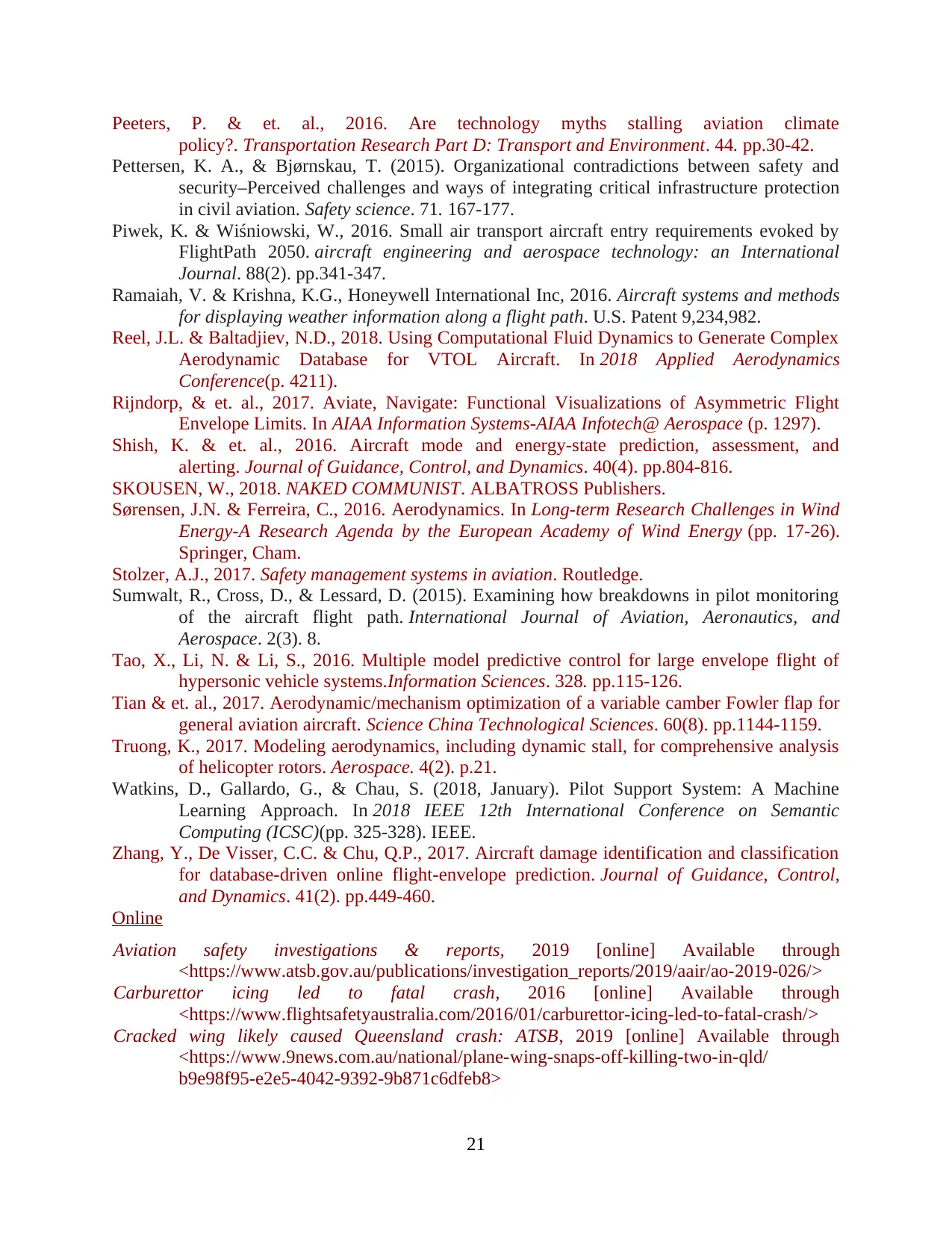
Peeters, P. & et. al., 2016. Are technology myths stalling aviation climate
policy?. Transportation Research Part D: Transport and Environment. 44. pp.30-42.
Pettersen, K. A., & Bjørnskau, T. (2015). Organizational contradictions between safety and
security–Perceived challenges and ways of integrating critical infrastructure protection
in civil aviation. Safety science. 71. 167-177.
Piwek, K. & Wiśniowski, W., 2016. Small air transport aircraft entry requirements evoked by
FlightPath 2050. aircraft engineering and aerospace technology: an International
Journal. 88(2). pp.341-347.
Ramaiah, V. & Krishna, K.G., Honeywell International Inc, 2016. Aircraft systems and methods
for displaying weather information along a flight path. U.S. Patent 9,234,982.
Reel, J.L. & Baltadjiev, N.D., 2018. Using Computational Fluid Dynamics to Generate Complex
Aerodynamic Database for VTOL Aircraft. In 2018 Applied Aerodynamics
Conference(p. 4211).
Rijndorp, & et. al., 2017. Aviate, Navigate: Functional Visualizations of Asymmetric Flight
Envelope Limits. In AIAA Information Systems-AIAA Infotech@ Aerospace (p. 1297).
Shish, K. & et. al., 2016. Aircraft mode and energy-state prediction, assessment, and
alerting. Journal of Guidance, Control, and Dynamics. 40(4). pp.804-816.
SKOUSEN, W., 2018. NAKED COMMUNIST. ALBATROSS Publishers.
Sørensen, J.N. & Ferreira, C., 2016. Aerodynamics. In Long-term Research Challenges in Wind
Energy-A Research Agenda by the European Academy of Wind Energy (pp. 17-26).
Springer, Cham.
Stolzer, A.J., 2017. Safety management systems in aviation. Routledge.
Sumwalt, R., Cross, D., & Lessard, D. (2015). Examining how breakdowns in pilot monitoring
of the aircraft flight path. International Journal of Aviation, Aeronautics, and
Aerospace. 2(3). 8.
Tao, X., Li, N. & Li, S., 2016. Multiple model predictive control for large envelope flight of
hypersonic vehicle systems.Information Sciences. 328. pp.115-126.
Tian & et. al., 2017. Aerodynamic/mechanism optimization of a variable camber Fowler flap for
general aviation aircraft. Science China Technological Sciences. 60(8). pp.1144-1159.
Truong, K., 2017. Modeling aerodynamics, including dynamic stall, for comprehensive analysis
of helicopter rotors. Aerospace. 4(2). p.21.
Watkins, D., Gallardo, G., & Chau, S. (2018, January). Pilot Support System: A Machine
Learning Approach. In 2018 IEEE 12th International Conference on Semantic
Computing (ICSC)(pp. 325-328). IEEE.
Zhang, Y., De Visser, C.C. & Chu, Q.P., 2017. Aircraft damage identification and classification
for database-driven online flight-envelope prediction. Journal of Guidance, Control,
and Dynamics. 41(2). pp.449-460.
Online
Aviation safety investigations & reports, 2019 [online] Available through
<https://www.atsb.gov.au/publications/investigation_reports/2019/aair/ao-2019-026/>
Carburettor icing led to fatal crash, 2016 [online] Available through
<https://www.flightsafetyaustralia.com/2016/01/carburettor-icing-led-to-fatal-crash/>
Cracked wing likely caused Queensland crash: ATSB, 2019 [online] Available through
<https://www.9news.com.au/national/plane-wing-snaps-off-killing-two-in-qld/
b9e98f95-e2e5-4042-9392-9b871c6dfeb8>
21
policy?. Transportation Research Part D: Transport and Environment. 44. pp.30-42.
Pettersen, K. A., & Bjørnskau, T. (2015). Organizational contradictions between safety and
security–Perceived challenges and ways of integrating critical infrastructure protection
in civil aviation. Safety science. 71. 167-177.
Piwek, K. & Wiśniowski, W., 2016. Small air transport aircraft entry requirements evoked by
FlightPath 2050. aircraft engineering and aerospace technology: an International
Journal. 88(2). pp.341-347.
Ramaiah, V. & Krishna, K.G., Honeywell International Inc, 2016. Aircraft systems and methods
for displaying weather information along a flight path. U.S. Patent 9,234,982.
Reel, J.L. & Baltadjiev, N.D., 2018. Using Computational Fluid Dynamics to Generate Complex
Aerodynamic Database for VTOL Aircraft. In 2018 Applied Aerodynamics
Conference(p. 4211).
Rijndorp, & et. al., 2017. Aviate, Navigate: Functional Visualizations of Asymmetric Flight
Envelope Limits. In AIAA Information Systems-AIAA Infotech@ Aerospace (p. 1297).
Shish, K. & et. al., 2016. Aircraft mode and energy-state prediction, assessment, and
alerting. Journal of Guidance, Control, and Dynamics. 40(4). pp.804-816.
SKOUSEN, W., 2018. NAKED COMMUNIST. ALBATROSS Publishers.
Sørensen, J.N. & Ferreira, C., 2016. Aerodynamics. In Long-term Research Challenges in Wind
Energy-A Research Agenda by the European Academy of Wind Energy (pp. 17-26).
Springer, Cham.
Stolzer, A.J., 2017. Safety management systems in aviation. Routledge.
Sumwalt, R., Cross, D., & Lessard, D. (2015). Examining how breakdowns in pilot monitoring
of the aircraft flight path. International Journal of Aviation, Aeronautics, and
Aerospace. 2(3). 8.
Tao, X., Li, N. & Li, S., 2016. Multiple model predictive control for large envelope flight of
hypersonic vehicle systems.Information Sciences. 328. pp.115-126.
Tian & et. al., 2017. Aerodynamic/mechanism optimization of a variable camber Fowler flap for
general aviation aircraft. Science China Technological Sciences. 60(8). pp.1144-1159.
Truong, K., 2017. Modeling aerodynamics, including dynamic stall, for comprehensive analysis
of helicopter rotors. Aerospace. 4(2). p.21.
Watkins, D., Gallardo, G., & Chau, S. (2018, January). Pilot Support System: A Machine
Learning Approach. In 2018 IEEE 12th International Conference on Semantic
Computing (ICSC)(pp. 325-328). IEEE.
Zhang, Y., De Visser, C.C. & Chu, Q.P., 2017. Aircraft damage identification and classification
for database-driven online flight-envelope prediction. Journal of Guidance, Control,
and Dynamics. 41(2). pp.449-460.
Online
Aviation safety investigations & reports, 2019 [online] Available through
<https://www.atsb.gov.au/publications/investigation_reports/2019/aair/ao-2019-026/>
Carburettor icing led to fatal crash, 2016 [online] Available through
<https://www.flightsafetyaustralia.com/2016/01/carburettor-icing-led-to-fatal-crash/>
Cracked wing likely caused Queensland crash: ATSB, 2019 [online] Available through
<https://www.9news.com.au/national/plane-wing-snaps-off-killing-two-in-qld/
b9e98f95-e2e5-4042-9392-9b871c6dfeb8>
21

NTSB Determines Continuation of Unstabilized Visual Approach, Stall Caused Teterboro Crash,
2019 [online] Available through
<https://www.ntsb.gov/news/press-releases/Pages/NR20190312.aspx>
22
2019 [online] Available through
<https://www.ntsb.gov/news/press-releases/Pages/NR20190312.aspx>
22
1 out of 24
Your All-in-One AI-Powered Toolkit for Academic Success.
+13062052269
info@desklib.com
Available 24*7 on WhatsApp / Email
![[object Object]](/_next/static/media/star-bottom.7253800d.svg)
Unlock your academic potential
© 2024 | Zucol Services PVT LTD | All rights reserved.